The Breakdown
Pros
Cons
Video Review
The New Shoei RF-1400 = A Shoei RF-1200 + ‘Kaizen’
I love being among the first people to try something new and then telling everyone I know all about it!
Shoei has morphed its already popular RF-1200 helmet into this even more refined RF-1400 incarnation. They are pumped about the updates and touting it as an example of “perfection” achieved through the company’s devotion to a Japanese philosophy of gradual improvement called Kaizen.
#SHOEIWHATSINTHEBOX
I received a locked lucite box last week from Shoei Helmets North America with a promise they’d give me the combination to open it on December 2nd when the official media release was scheduled. Thank you for including me Shoei!!
They didn’t tell me what the helmet was inside, only that it was a big deal.
What a fun promotional idea to get people wondering what could be the newest member of the Shoei family, or which model was getting an upgrade.
I was all in as you can see from this video.
I launched a contest to have people guess the code to open the box on our WebBikeWorld Facebook page and my Instagram account @webbikeworld.jim. Additionally, I asked viewers and fans to guess what kind of helmet was inside.
I couldn’t believe it when two people guessed the code correctly almost right away, and one person even said that it would be the RF-1400!
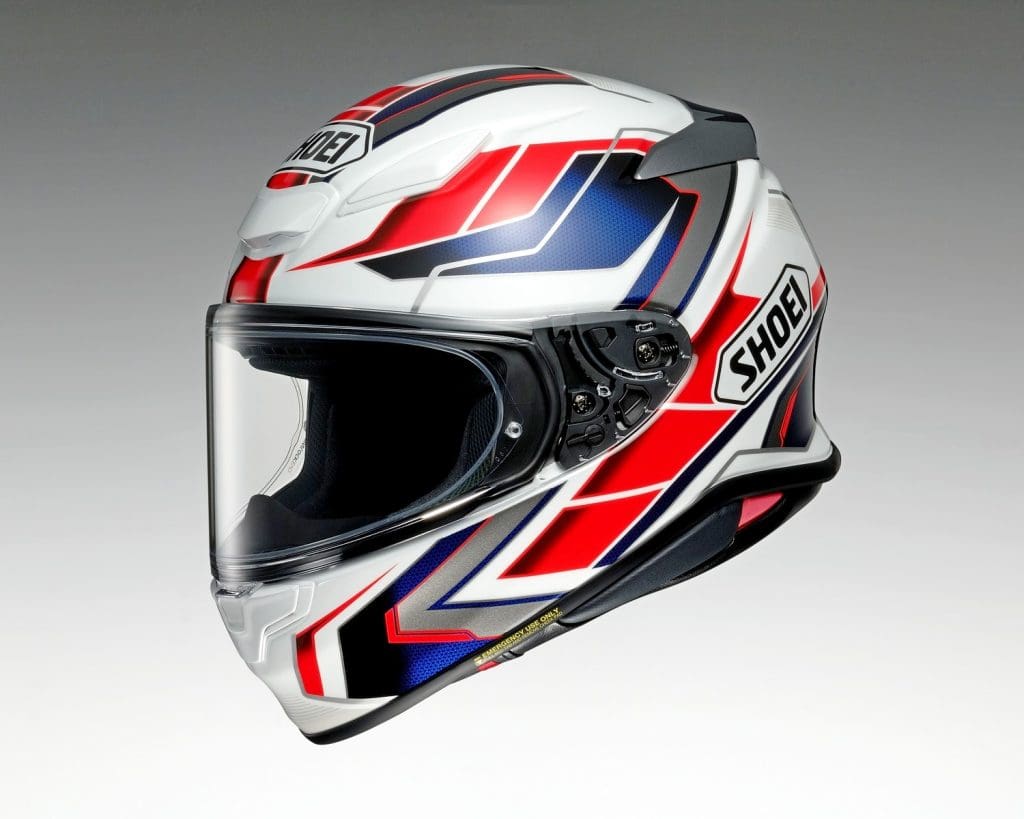
Good job Brandy and John! You two are very sharp.
I sent both winners some swag from wBW and Shoei as a thank you for playing along. A motorcycle gear distribution company named Helmet House saw the excitement about it on Instagram and provided the Shoei swag without me even asking for it!
Thank you for that, Nicole!
The Changes
Looking at the photo below showing the RF-1200 vs. RF-1400 you’ll see much has been… “Kaizen’ed”. The RF-1400 isn’t just an RF-1200 with bold new colors and graphics even though the family resemblance is evident.
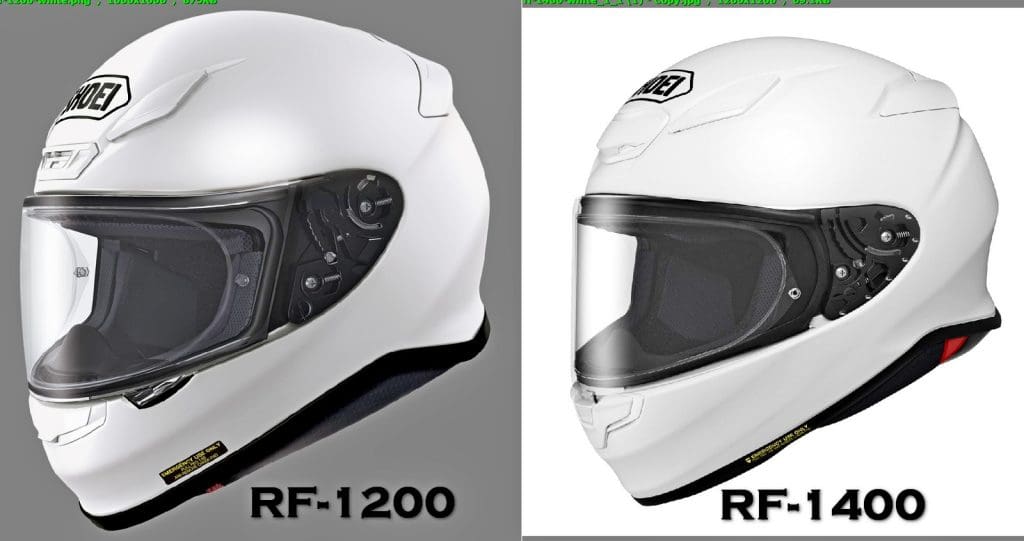
The shell is different in shape and height, but the Multi-ply, matrix AIM+ mixture of fiberglass and organic fibers is still what it’s made from.
The RF-1400 shell will come in 4 different sizes and have the usual 5-year warranty Shoei is known for.
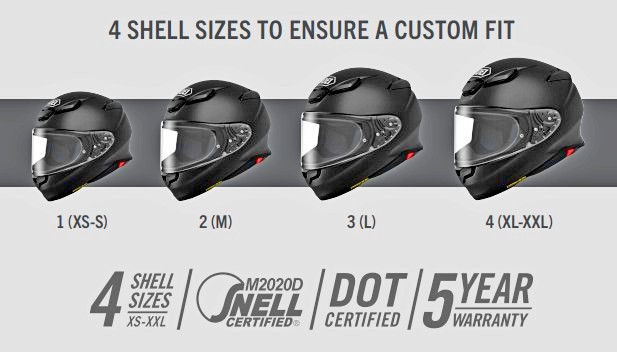
Lightweight
I put this size Large on my scale to see how it stacks up with Shoei’s claims.
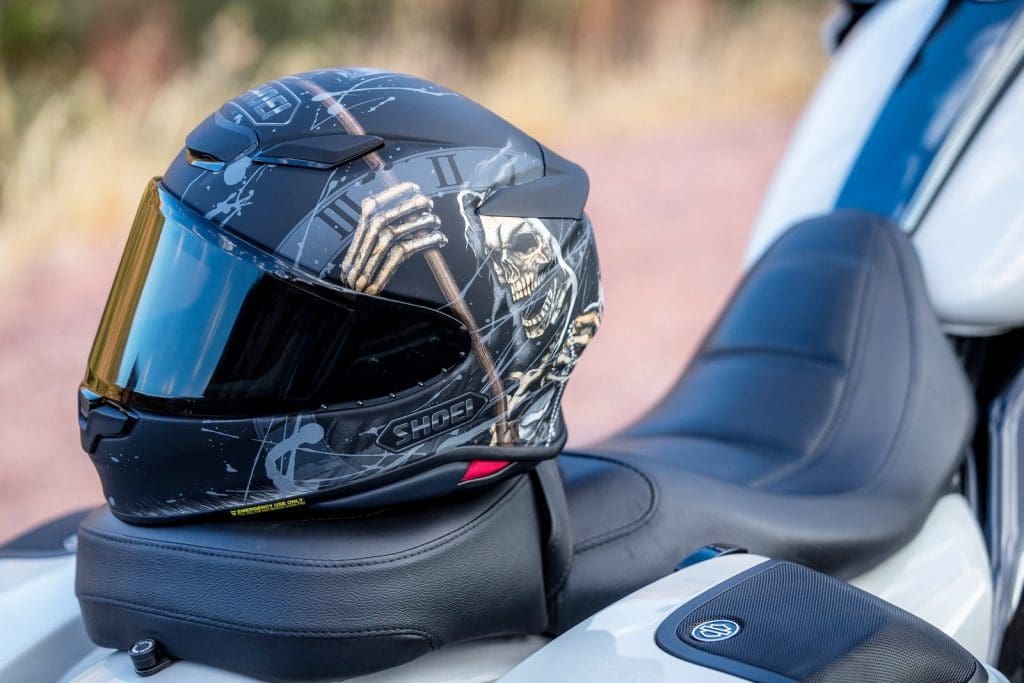
3.76lbs or 1706g is a very lightweight Snell M2020 approved helmet. If it were made of carbon fiber I’m sure it would be flirting with the 3lb mark, but the Shoei reps addressed this in their presentation by saying they don’t find Carbon Fiber easy enough to work with while trying to achieve the exact degree of flex desired in their helmet shells.
It sounds a bit odd to hear that a helmet shell should flex, but hey, they’re the helmet manufacturing experts, not I.
The people at Arai also prefer not to use Carbon Fiber so I believe it’s a valid point.
This is the lightest Snell M2020 rated full-face helmet Shoei makes so you can wear it confident in its ability to protect your head in a severe crash.
Out on the road (or even just walking around wearing it), this helmet feels lighter than it is. I believe this is thanks to a low center of gravity and the weight is equally divided from front to rear.
It’s a thing of beauty, and one of the small details you can expect to find is addressed in a hand-crafted helmet like this one.
Head Shape and Sizing
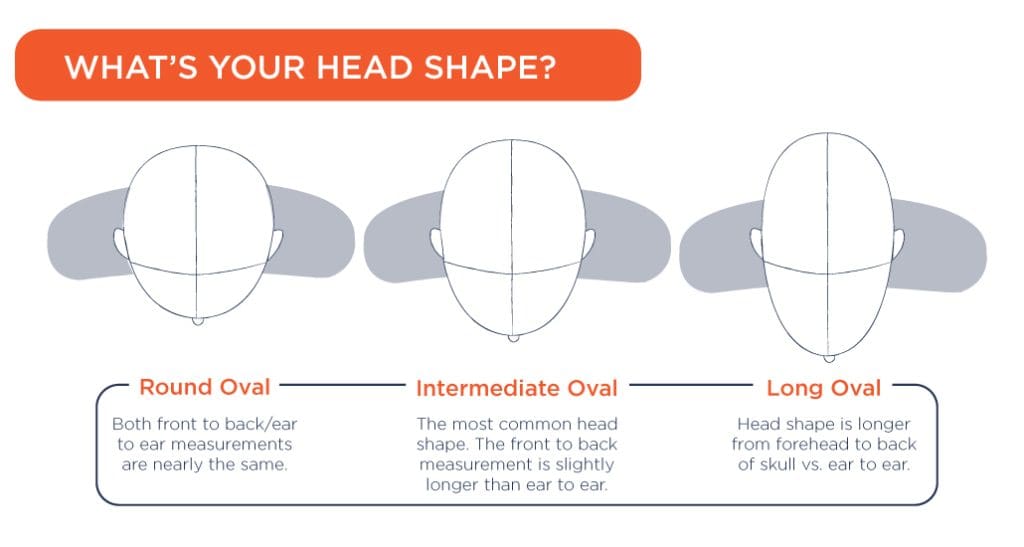
This new helmet fits me better than any other Shoei helmet I’ve road tested to date (Neotec 2, GT Air, GT Air 2)! I was glad to discover this RF-1400 appears to have a more rounded or neutral bias to its intermediate oval shape.
They sent me a size Large as opposed to my usually requested Medium because some sizes were in short supply for this early media release party. My 23” or 58.45cm head falls in no man’s land between Medium and Large, and so it was a new experience going up a size for this review.
After logging ~300 miles, I’m encountering some minor movement around my forehead due to the liner material relaxing/breaking in.
I recently began wearing an approximately 2mm thick helmet liner while riding and I tried it in this new Shoei. That added thickness has taken up the small amount of slack in the forehead area, and the RF-1400 now fits me just right again.
Regardless, I may try a slightly thicker crown liner down the road or get a size Medium RF-1400 if available with a thinner set of padding to compare the two, assuming Shoei is willing to play along with my proposal.
Visor and Field of View
Shoei sent me both a tinted and clear visor with my sample helmet, but it only comes with a clear one when purchased. The tinted visor is dark enough for sunny days, but if I’ve got the sun shining directly in my eyes I find myself wishing for an additional layer of tint. I was able to use sunglasses in the RF-1400 without discomfort or issues.
I’d rather the tint be on the lighter side than too dark because a couple of times before now, I’ve found myself caught out after sunset with a visor that was too dark to use safely. That long ride home isn’t an experience I’d like to have too often.
A Transitions Visor Is Tops
I inquired with Shoei and was told a Transitions (auto-darkening) visor will also be available for the RF-1400 in April or May 2021. That’s the ideal visor to be wearing on this helmet in my mind, notwithstanding how expensive it is to buy and the limited life expectancy.
Shoei has redesigned the RF-1400 Pinlock mounts, baseplates, release mechanism, and seal for the visor.
Everything has been shifted back out of the wearer’s peripheral vision according to Shoei, thus improving the field of view out of the eyeport.
In the limited road testing I’ve done with the helmet thus far I’ve noted an increased ability to see around me comfortably thanks to those changes. I’ve also confirmed that the Pinlock mounting “buds” don’t show up in my peripheral field of view as Shoei intended. Well done!
This redesigned shape also helps cut down on wind noise flowing over the visor. More on that later.
The Baseplate Mechanism
I don’t like how some visors make overly loud “clunking” noises when raised or lowered. I find the original GT Air to be one example of a clunky mechanism. Conversely, the Arai XD-4 and Schuberth C4 are two of my favorite quiet ones.
This RF-1400 is somewhere in the middle of those helmets mentioned above. It’s quieter and smoother than the GT Air or GT Air 2 but not at the silk-like level of the XD-4 and C4.
A New Seal
The visor seal (beading) has changed to a rounded or tubular shape complete with drain holes on either side for moisture and air expulsion (photo above).
Waterproof Seal?
I haven’t ridden with this helmet in the rain yet, but I did hold it under running water for several minutes to try and gauge how well the new seal performs.
It did leak (as 99%) of visor seals will when treated this way, but only slightly. I think it might seal better with wind force pushing on the visor while out riding.
I’ll come back and update this next year when I get the opportunity to real-world rain test the RF-1400.
The Pinlock EVO
A Pinlock EVO lens comes included with the helmet as standard but I haven’t installed it yet.
It was only 10 degrees Celsius (50 Fahrenheit) during the initial test ride I managed with the helmet and it would fog up when I was stopped at a light or in traffic. The fogging cleared quickly and easily with limited effort on my part. Cracking the visor open was enough to clear most of it. Moving slowly got rid of it altogether.
I think I’ll leave the Pinlock out until I feel obliged to have it in. The visor is noticeably clearer without it. Optically perfect is an often overused cliché in moto journalist scribblings, but it’s accurate when it comes to describing this CWR-F2 lens.
CWR-F2 BASE PLATE SYSTEM
- Completely redesigned to facilitate quicker, smoother shield changes
- The new shield adjuster mechanism provides easier, more precise tuning
- Redesigned base plate gear has an all-new “first position” shield opening feature for advanced venting and defogging (I’m very happy to see this feature!)
- SHOEI’s patented spring-loaded technology ensures a wind and waterproof seal
- All-new airtight window beading reduces wind and water intrusion
It looks like it’s going to work well, but I need to ride at least 600 miles on the road with it to know for sure. I’m well short of that at this point.
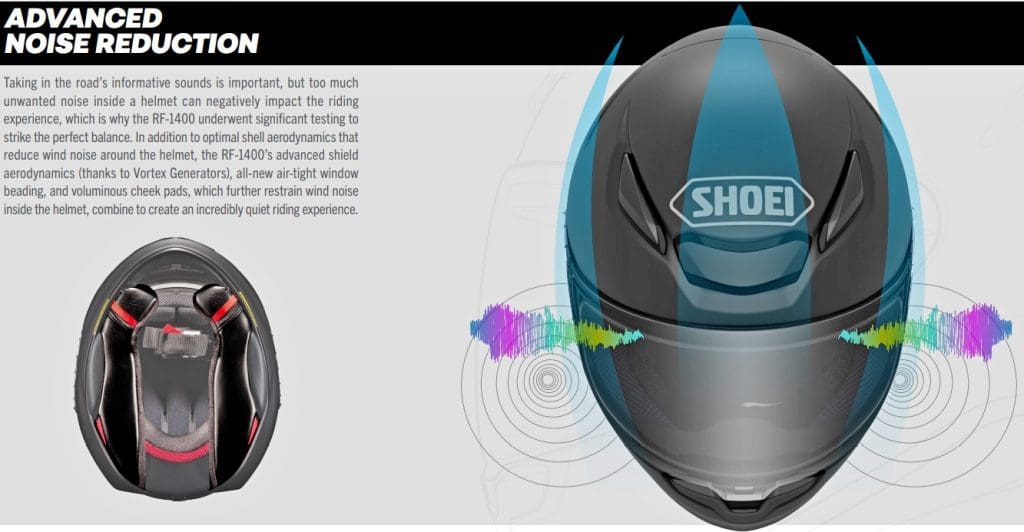
The release mechanism for the visor lock has moved from the left side to the center of the chin bar (photo below). This is a plus, not only to allow ambidextrous use but also to stop placing stress unevenly on the visor lens each time it’s opened. I find it’s easy enough to locate and actuate with my gloved fingers while flying down the road.
I know some people would rather not see this change, but I think it’s positive.
Ventilation
I haven’t ever worn an RF-1200, but I’m told it has good ventilation. Shoei says the RF-1400 has superior airflow to the RF-1200 on the upper vent and less turbulent flow entering from the chin bar vent.
So Cool
They’re probably right about that.
The airflow and ventilation in this RF-1400 are easy for me to notice at highway speeds when the ambient air temperature is a chilly 10 Celsius (50 F), as you might imagine. In hot weather, it will be less apparent but present nonetheless and strong enough to keep the wearer comfortable in my estimation.
I don’t find it as drafty as the Klim Krios Pro is. The Klim makes me feel downright uncomfortable while riding at these temperatures with the vents all open, but I think the RF-1400 airflow may be slightly better than its higher-priced cousin the GT Air 2.
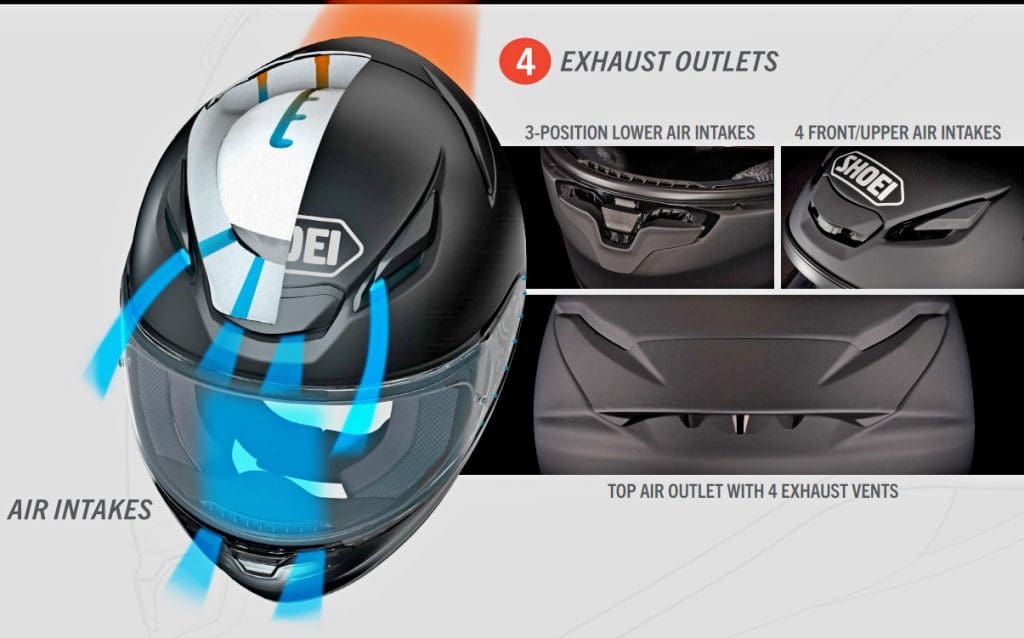
The vent sliders all move smoothly on this helmet, but I find it difficult to set them in the first open position as opposed to going all the way to the fully open position.
The detents on the first positions aren’t defined deeply enough to halt the slide, but I don’t think this matters much (to me at least) since typically I’m an all or nothing kind of guy when it comes to airflow in my helmet.
Lift and Pull
The Shoei wind tunnel must be running 24/7 judging by the looks and specs of this new helmet. I don’t blame them since if I had one I would do the same thing, but I would publish noise measurements from my helmets and compare them to the competition ones.
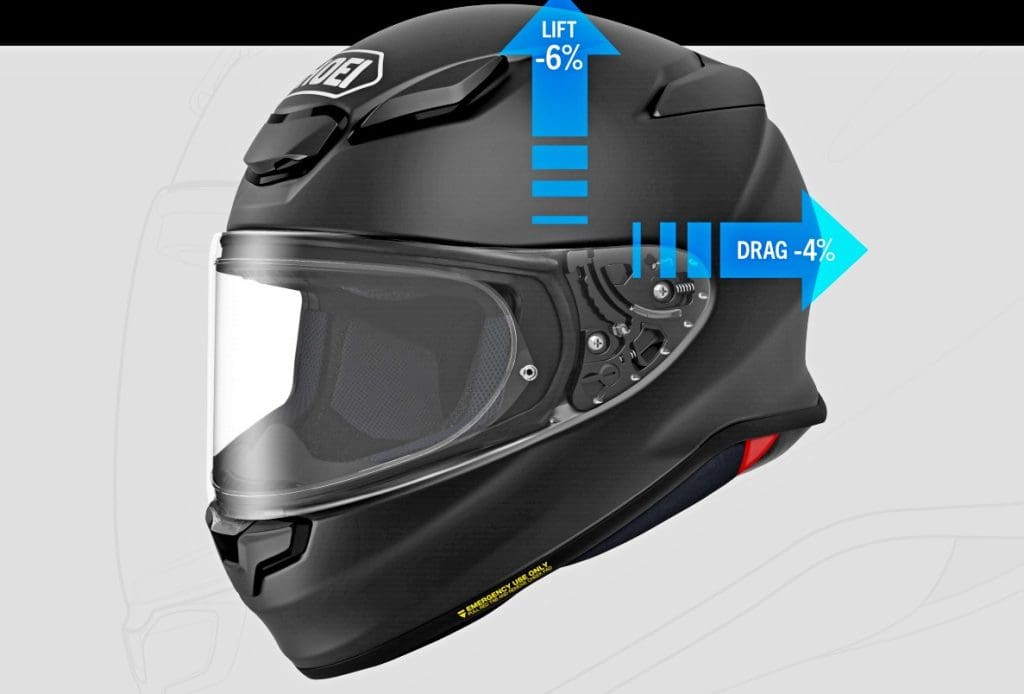
- Compact, aerodynamic shell shape with integrated spoiler
- Strategically-shaped air intake, and, exhaust vents help streamline the overall profile
- Strategically-shaped air intake and, exhaust vents help streamline the overall profile
- Boasts impressive improvements in aerodynamic performance and reduces the forces placed on a rider’s head
Lift reduction (upward lift forces): -6%*
Drag reduction (forward drag forces): -4%*
Do I think any rider will notice a 6% or 4% decrease in lift and drag? No, but those numbers show just how devoted Shoei is to substantiating their claims this helmet is perfection.
For my part, I can’t detect any lift or pull out on the road with this helmet. It’s outstanding and I would say it tracks… perfectly through the wind. There’s that word again.
Wind Noise
I hate commenting on how noisy or quiet a helmet is because it’s far too subjective. I crave a truly consistent and unbiased method for measuring noise we can rely upon instead, but I don’t have it. So, this is the best I can do for now.
In my humble opinion, this RF-1400 helmet is just as quiet as the one I judge all others by. The Shoei GT Air.
There’s zero wind roar or sharp hissing to be endured with this helmet even when I turn my head into the wind at different angles. It’s perfectly consistent, and I don’t wear earplugs so I’m sensitive to any noise while riding.
When I stand up on my footpegs at highways speed and stick my head up into the undisturbed air stream, all I can hear is a mixture of engine noise, high-pitched whining coming from the knobby Motoz Tractionator Adventure tires on my KTM 790 Adventure… and a subdued “FFFfffff ssssshhhhhh” of the air flowing over this helmet. It’s brilliant, and I feel no compulsion to wear earplugs with this one.
The only time I can get it to make any irritating noise is when I pop open the visor about ⅛” to the first position outside of locked shut. That’s when it does give off a higher-pitched whistle ever so slightly, but that’s it.
Ear Pockets
What makes this helmet more impressive when it comes to noise levels is the way my ears sit in an open area or shallow cavity of sorts. I don’t feel padding pushing up against them to deaden any vibration sounds. I can hear outside sounds very clearly through the helmet, but only the ones I need to hear. Like traffic, sirens, or people talking for example.
The GT Air conversely, is very quiet partly because I do have padding pushed right up against my ears.
The RF-1400 should be noisier because of this characteristic, and yet it isn’t!
The Interior Liner
Shoei has used their customary 3D Max-Dry II interior material on the comfort liner. It’s a high-quality, washable, antimicrobial liner with only one major change made to the bottom shaping of the cheek pads for this RF-1400.
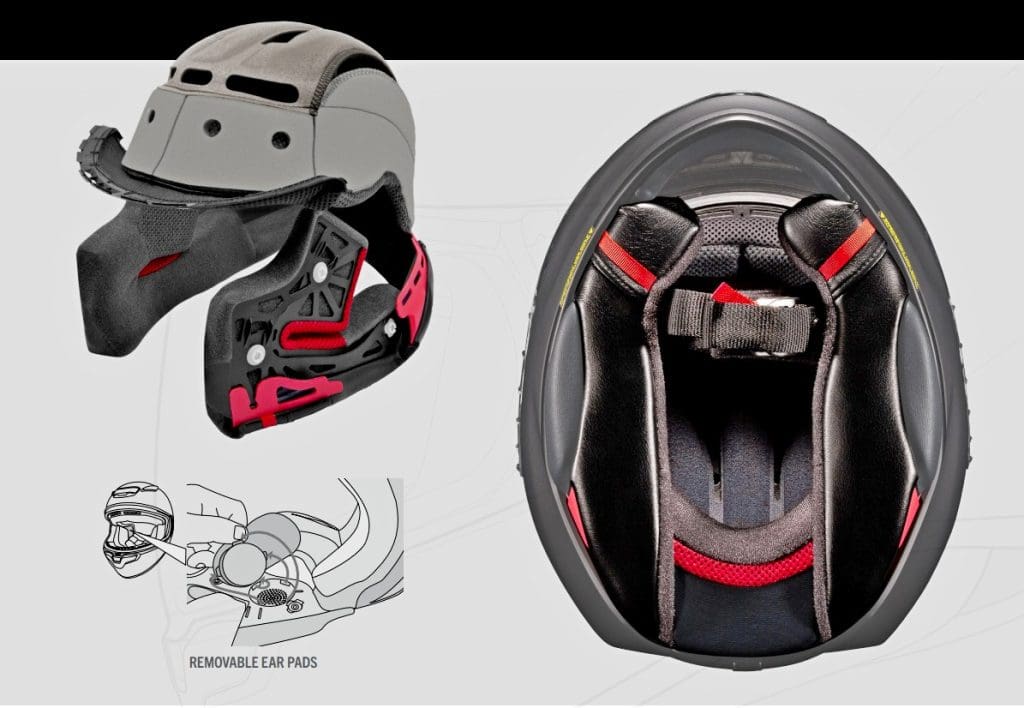
This new generation has a more pronounced curve to the facial pocket shape (like a catcher’s glove) to better cradle/seal against your jawline and theoretically block out wind and road noise more effectively when combined with the chin skirt.
People with more unusual jawlines may not benefit from this as much as I have, but it welds perfectly to my face. I’m also happy to find that when I remove the helmet this new style of padding and neckroll doesn’t attempt to tear my ears off on the way by.
When it comes to the overall comfort of the interior padding, this helmet ranks high for my head, but there are a couple of minor pressure points working on my cheek and orbital areas. This is only noticeable because of how totally uniform across my face and skull the interior padding fits in my two Arai helmets. So the RF-1400 comes close, but not equal to the almost custom-built interior degree of fitment I easily achieve with Shoei’s competitor.
3D MAX-DRY INTERIOR SYSTEM II
-
- Fully removable, washable, replaceable and adjustable
- Exclusive Max-Dry material absorbs and dissipates sweat 2X faster than traditional nylon interiors
- Soft yet durable lower cheek pad fabric for a plush fit and feel
- Three-dimensionally shaped to match the contours of a rider’s head
- Multi-layer cheek pads for improved comfort and helmet stabilization
- Cheek pads feature more volume for greater comfort and reduced wind noise
- Optional interior components available in different sizes for a customizable fit
Bluetooth Communicator Integration
You may have also noticed those two odd-shaped pads on the bottom of the helmet near the neck roll on either side. The rear red triangle is a fun accent aesthetically-speaking, but I wasn’t sure of the purpose at first.
It wasn’t brought up in the media brief but I emailed Shoei to ask about it afterward and they let me know these are shims or reinforcing braces for the new conforming cheek pad system. They help keep things tighter there to maintain the quieter ride.
What I do know is it sits right in the spot where I look to install clamp-on type Bluetooth units from Cardo/Sena, etc. The area on the shell around it is too sharply angled for use of the stick-on mounts to further complicate things.
Not to worry, Shoei will be releasing (in spring 2021) an RF-1400-specific, universal comm mount holder to help attach those devices.
Got Hi-Viz?
There are 6 solid color schemes and 14 fancier graphic options for this new helmet, but none are fluorescent Hi-Viz ones. I’ve already heard at least two people express their desire for that option on the next generation of RF-1400 helmets so I hope Shoei obliges on their 2022 models.
There aren’t any reflective patches, striping, etc, features on this Solid model I received either. Reflective stickers could easily fix this, but I think it’s something Shoei could tackle at the factory in a cleaner, tidier fashion.
The Solid colors cost $499.99 and the fancier ones are $599.99. Considering these are hand-made helmets with highly desirable features, that price grants a lot of value.
The new RF-1400 helmet will be available starting January 1, 2020.
Bargains on RF-1200 Helmets
If you can’t find the $499 to buy a new RF-1400, look on the bright side. I guarantee the “old news” RF-1200 model will be available for a much nicer price soon. This always happens when a new darling gets released, everyone falls in love with it and distributors blow out the old stock.
Make sure you watch these links in the next few days/weeks:
- RevZilla
- Amazon
- I see Helmet House has already dropped the price on it: https://helmethouse.com/shoei-rf-1200-helmet/
Final Verdict?
Is the RF-1400 helmet perfection as claimed?
I say it’s tantalizingly close and I would call it perfect with some very minor changes mentioned above.
At the 300 mile mark of testing, I’m impressed more than I expected to be.
Shoei should rename it the ‘Knife’ with how well it slices through the air and how sharp it looks. You might say it has an “edge” when compared to many other helmets too.
Shoei has got plenty to crow about with this one and it easily owns a spot in the top 4 helmets I’ve reviewed that are living in my collection.
Let me better put this in perspective. I’m a big fan of the Shoei GT Air 2, but given the choice, I’d reach for the RF-1400 first without hesitation.
The RF-1400 visor is smoother to operate, the field of view wider, it’s arguably better in a crash, lighter weight, more comfortable (for wider heads), less expensive to buy, flows air the same or better, and, is just as quiet. So, while I scored the GT Air 2 scored impressively high at 96%, I’m giving this RF-1400 a 97%.
Even at this early juncture in testing, I’m fully recommending it to anyone looking for a new full-face helmet.
– Jim
Pros
Cons
Review Details

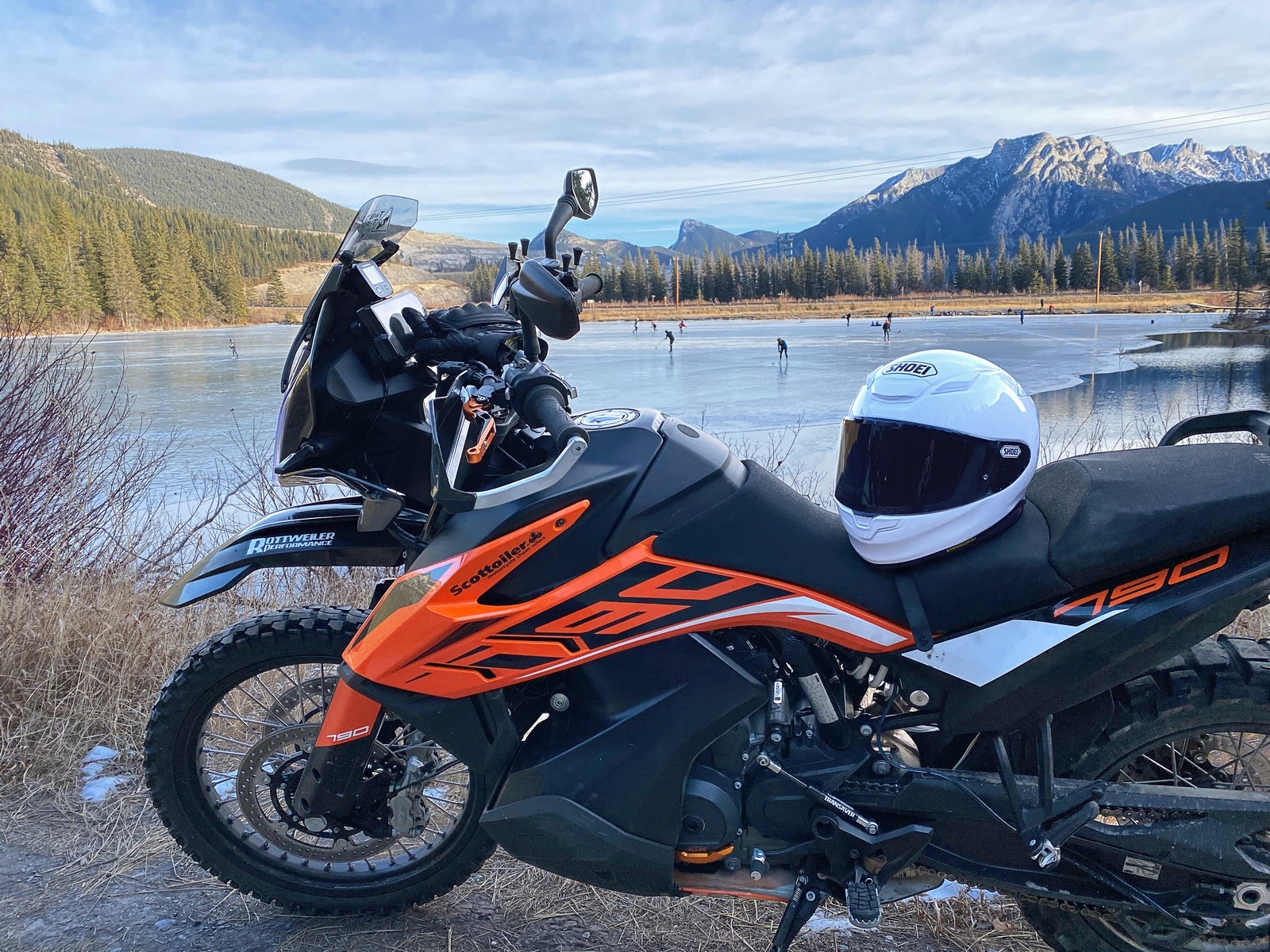
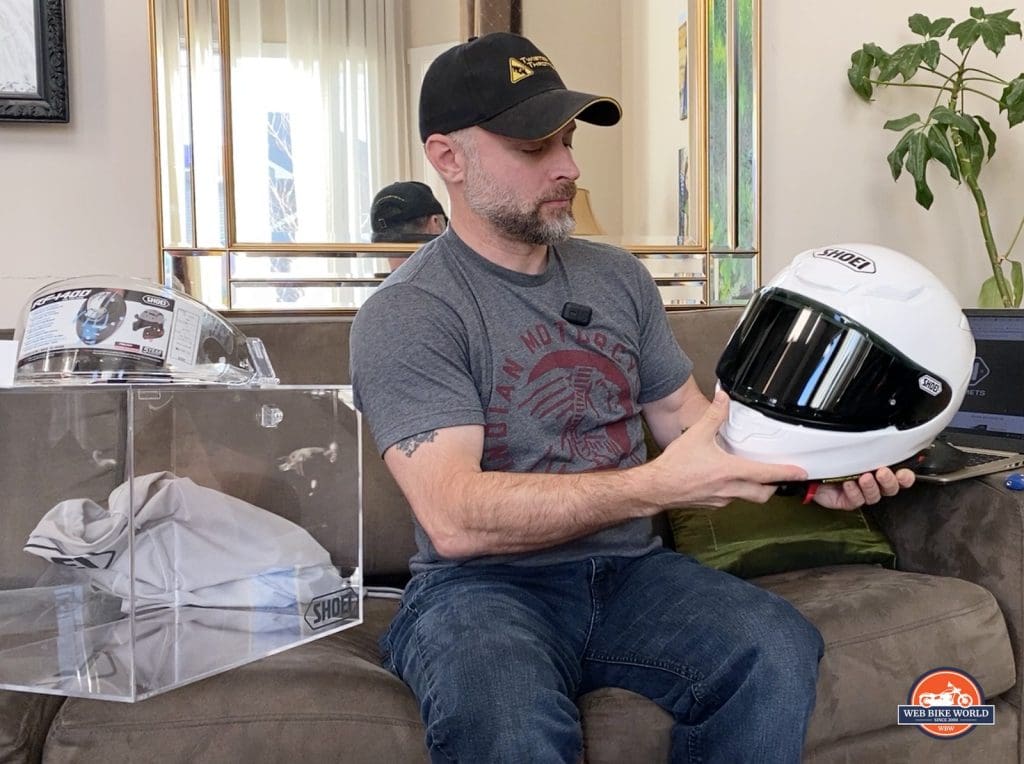
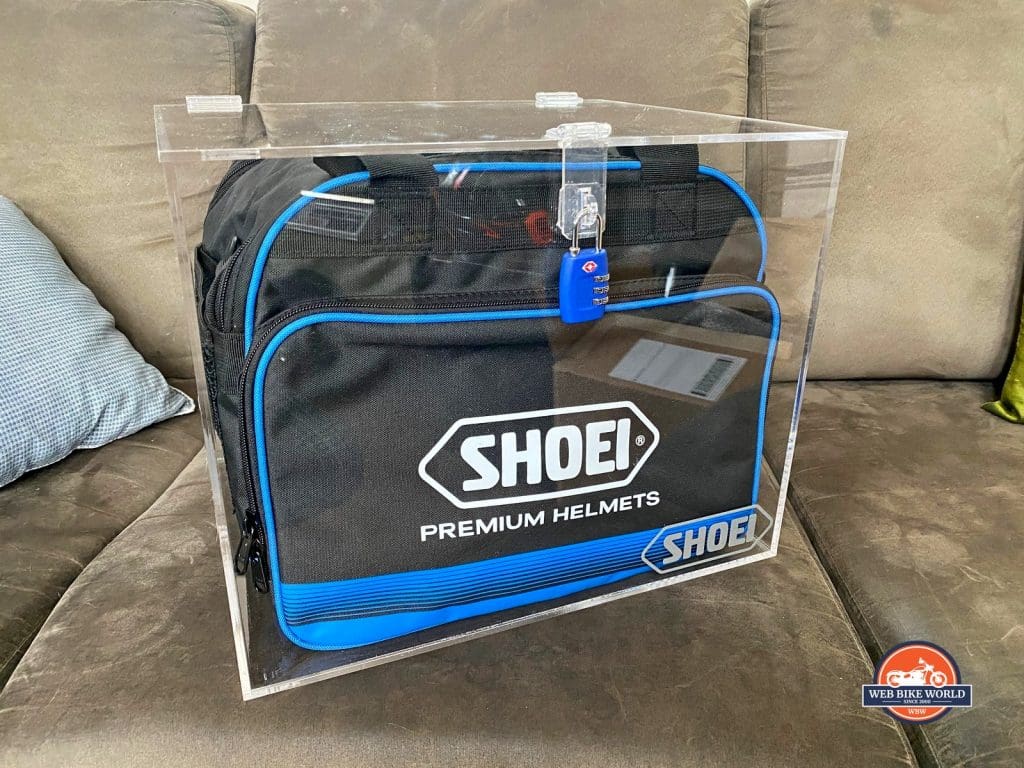
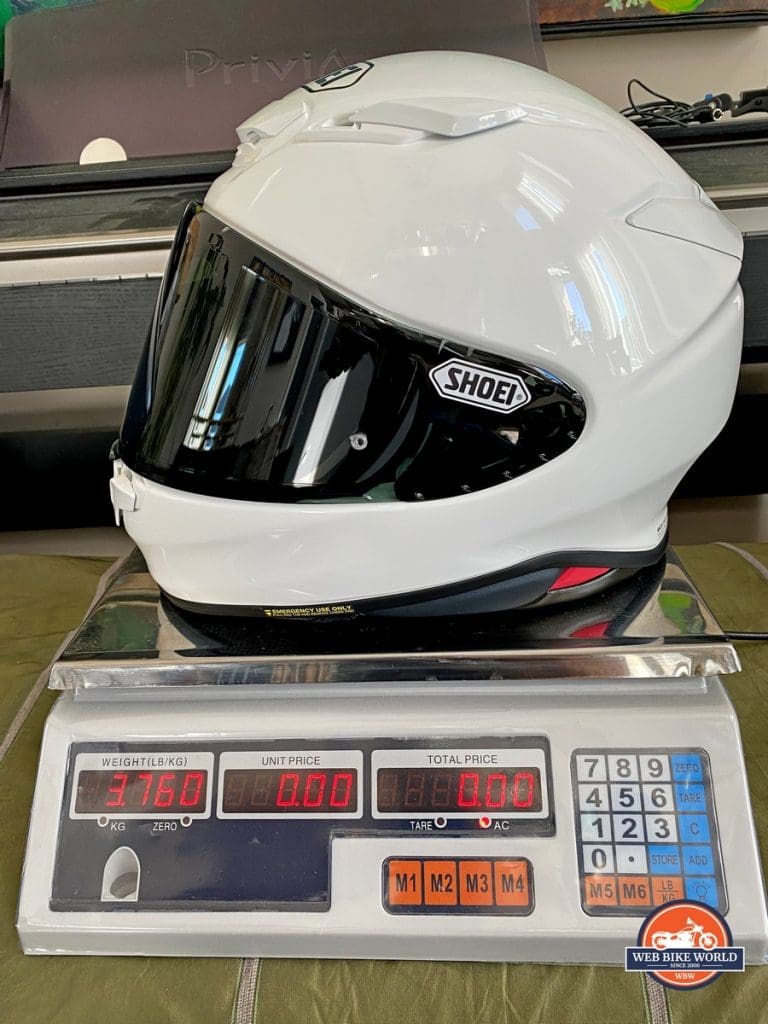
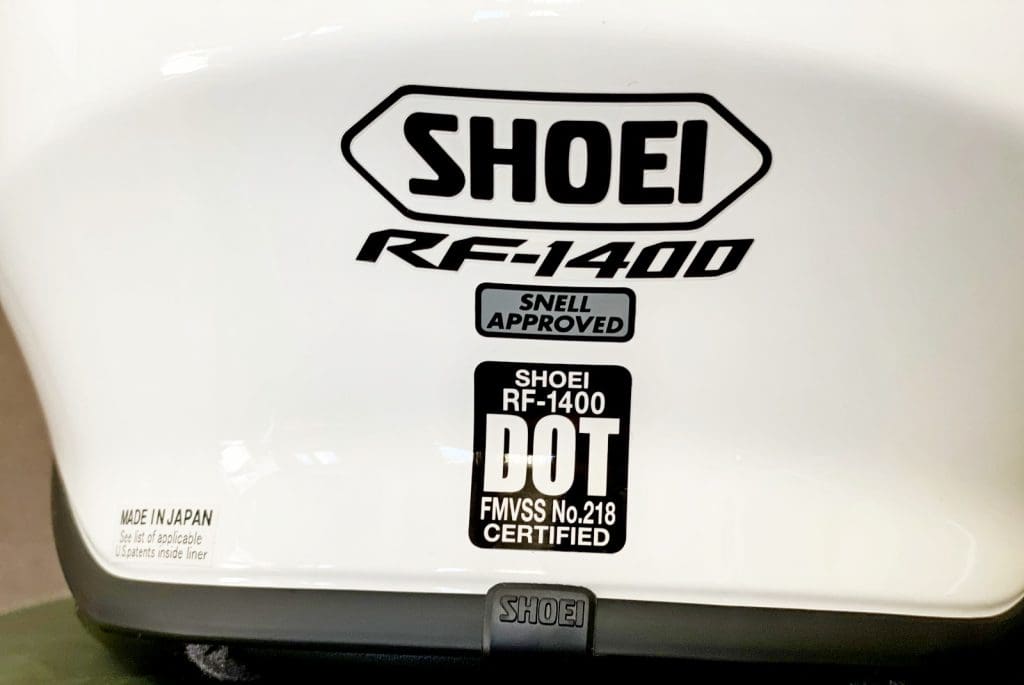
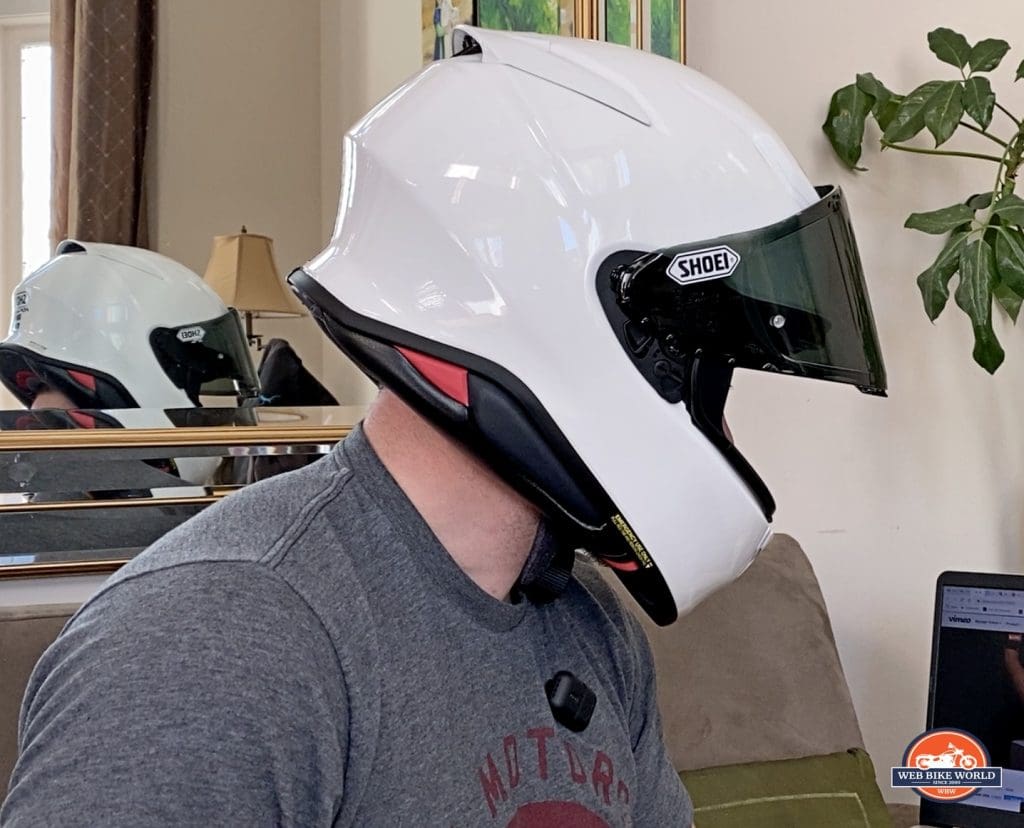
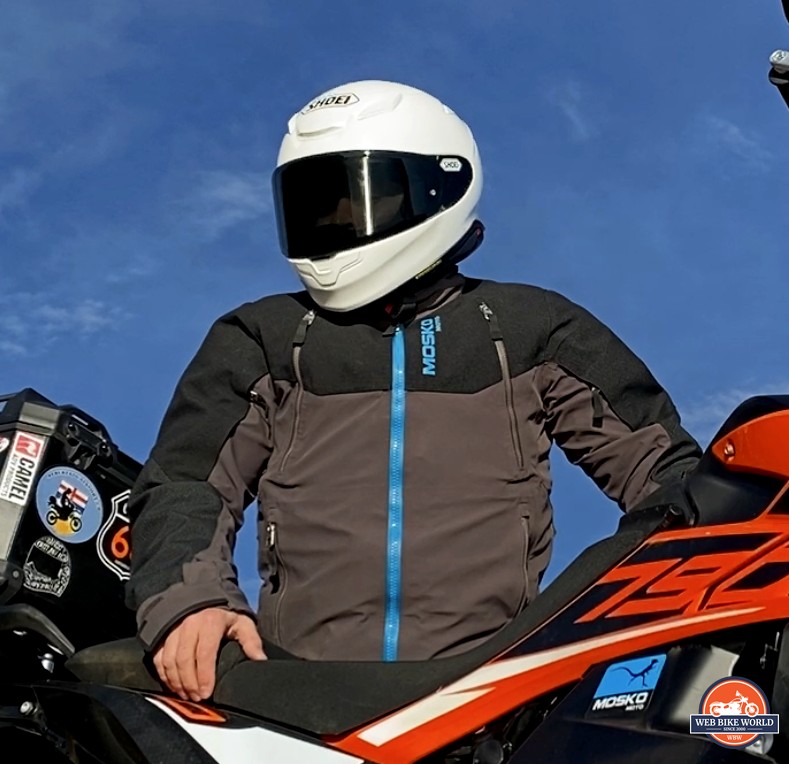
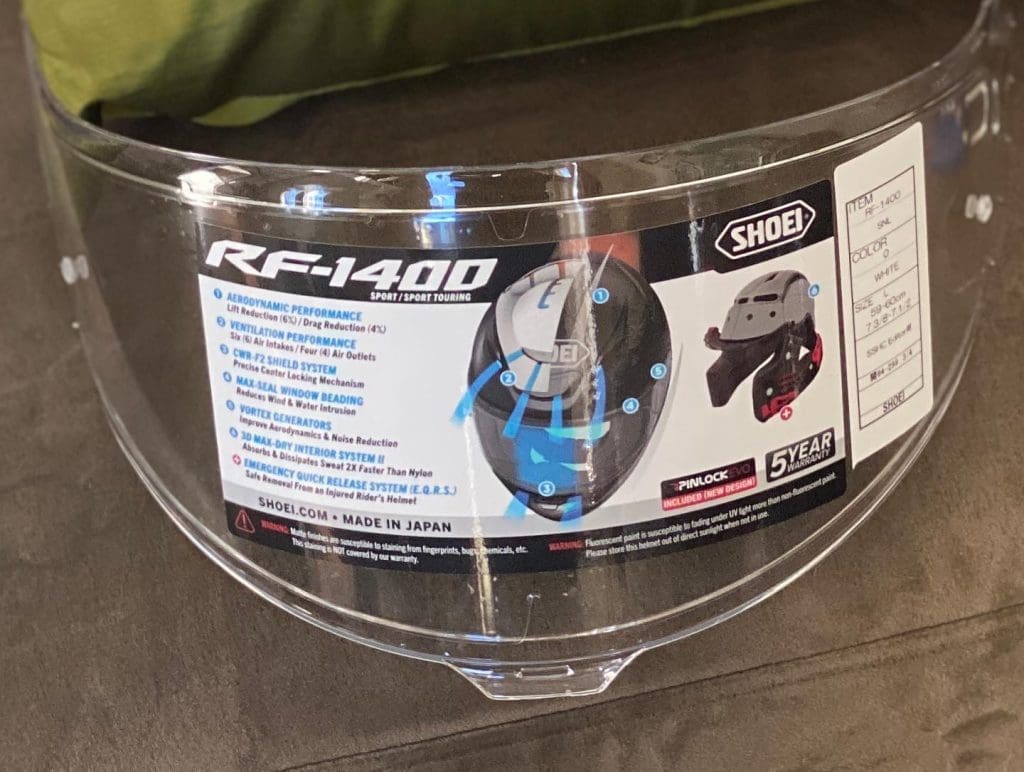
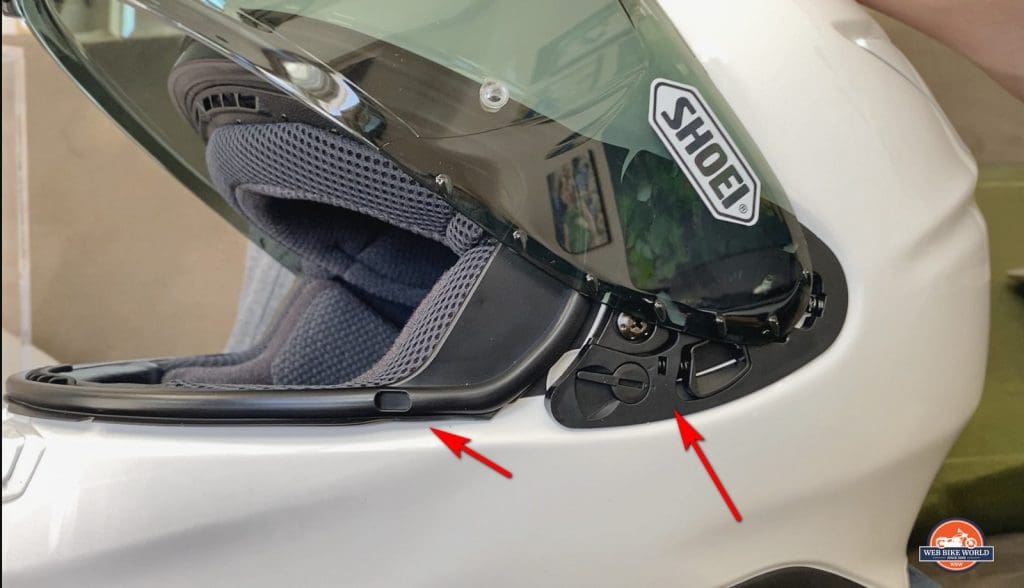
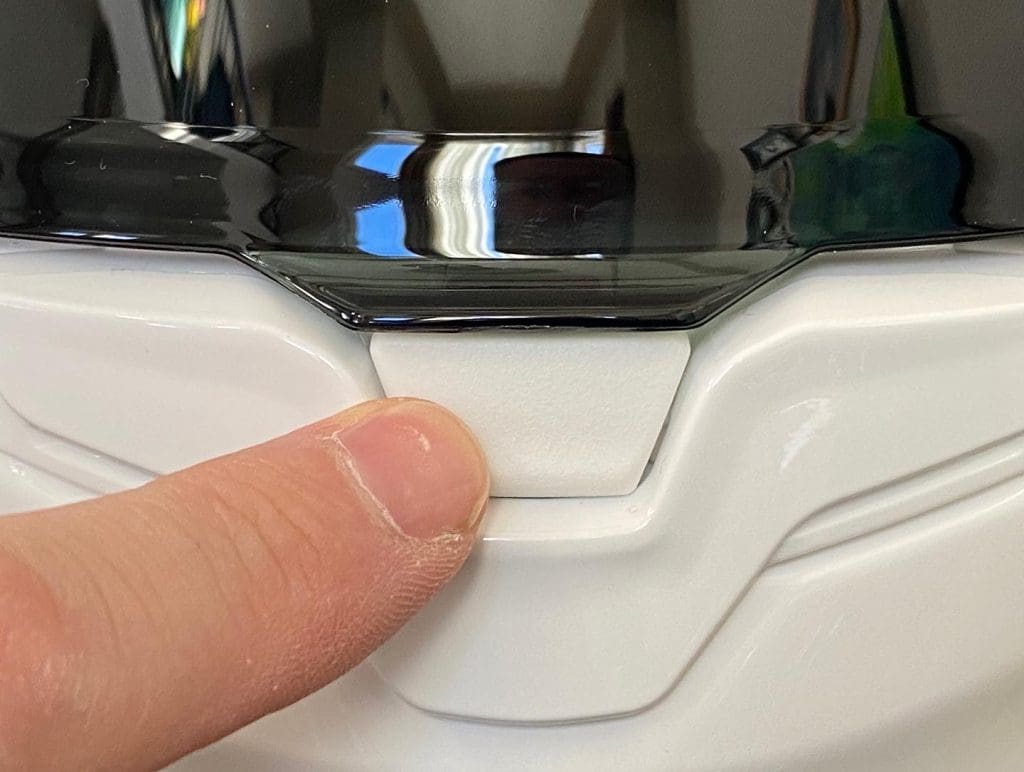
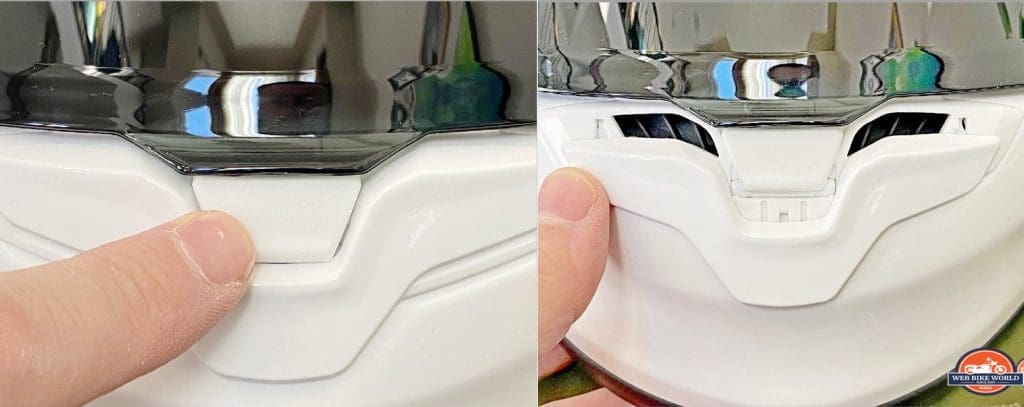
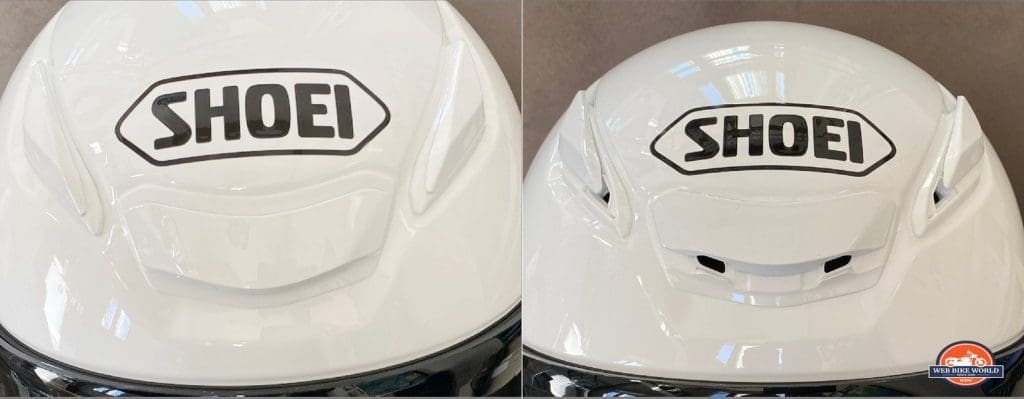
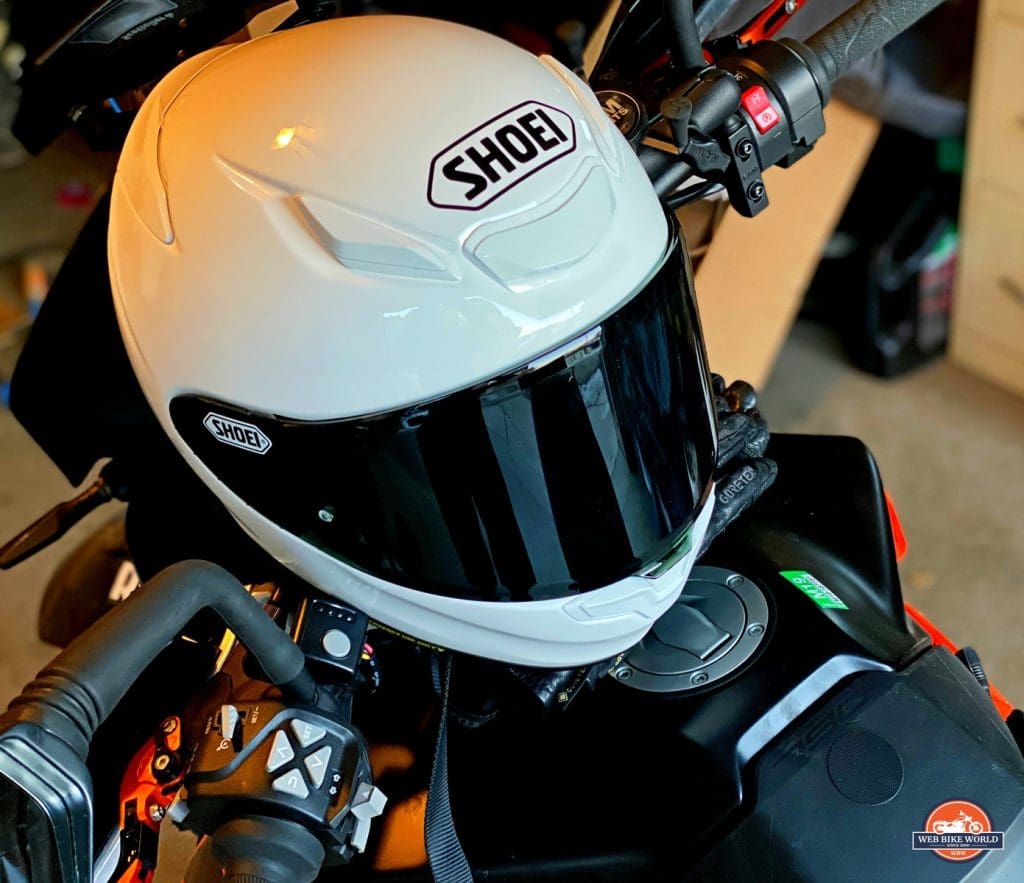
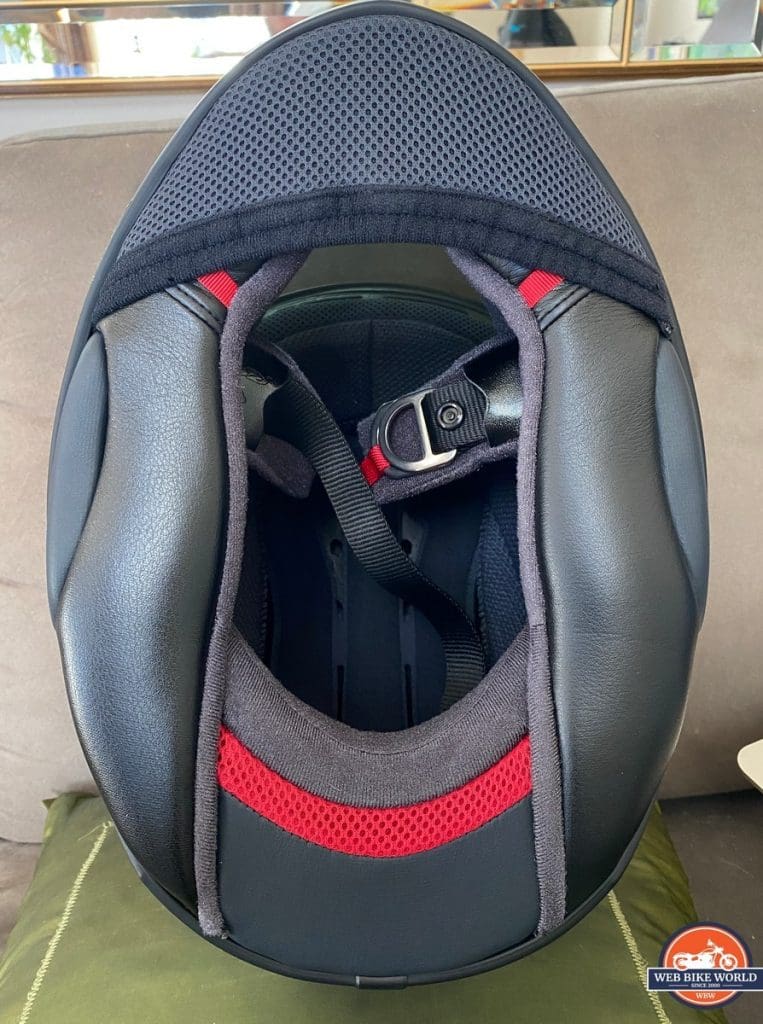
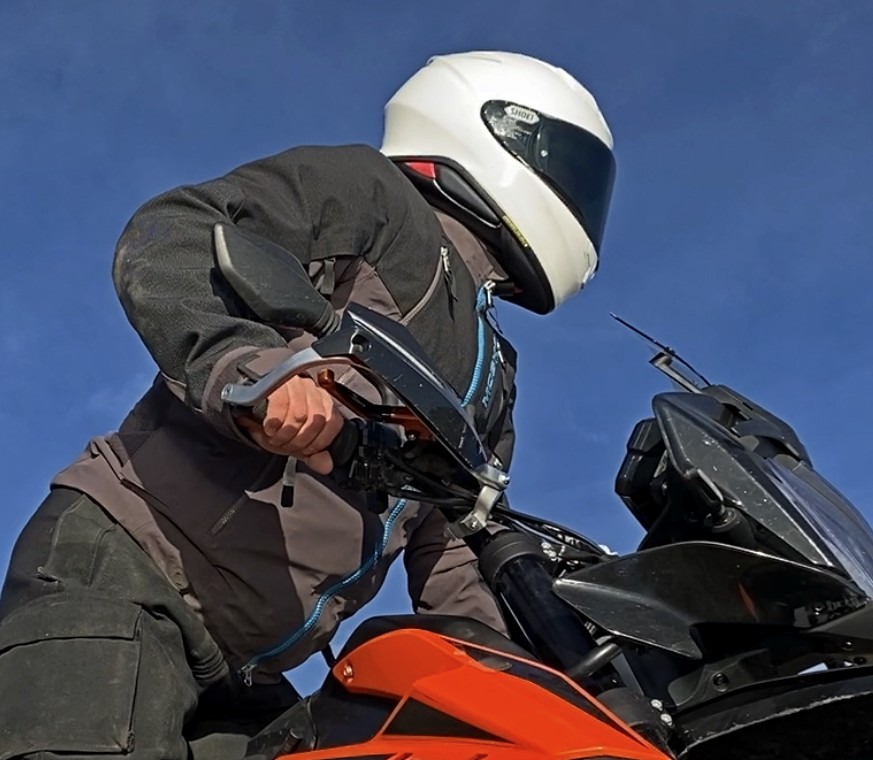
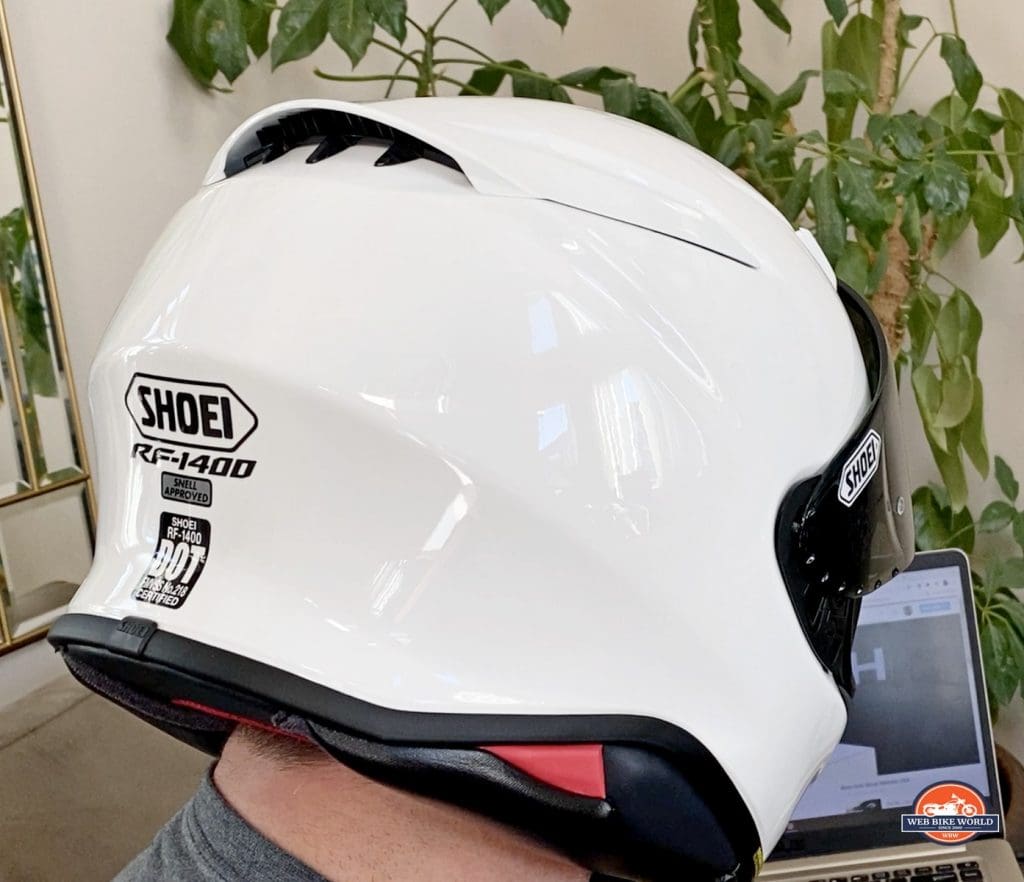
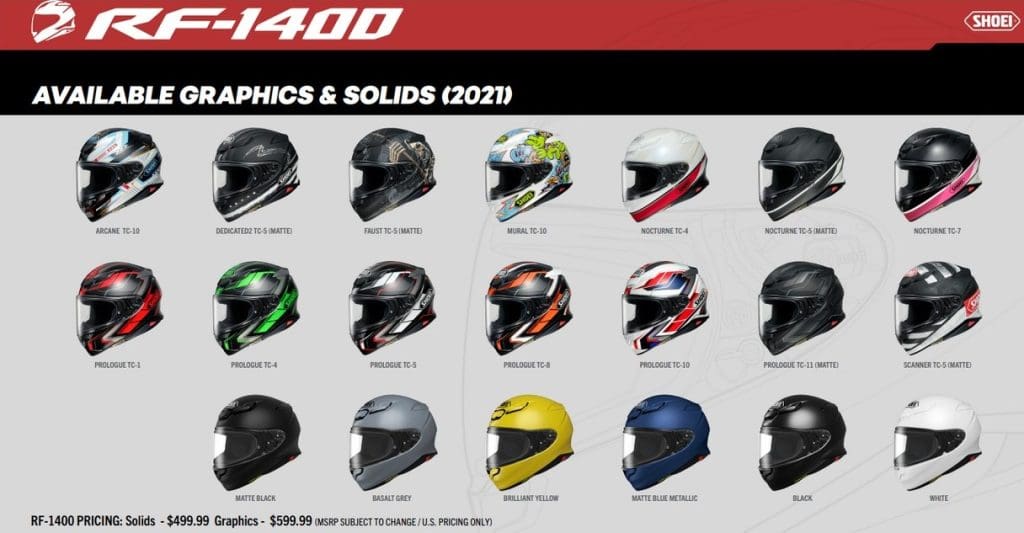
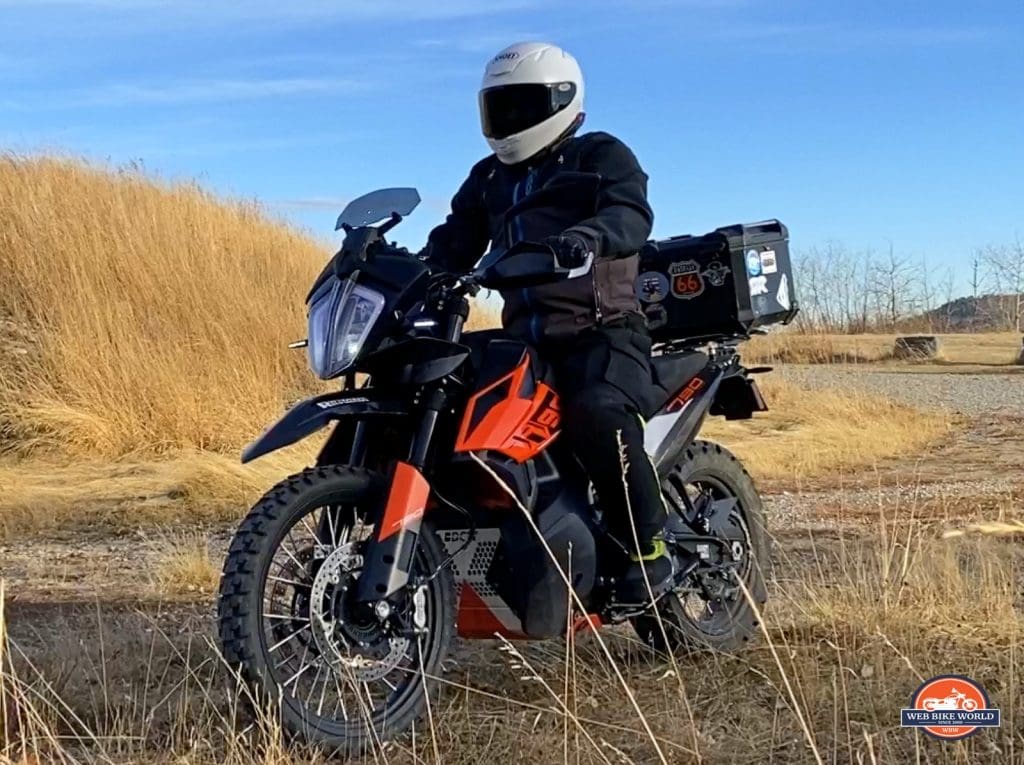
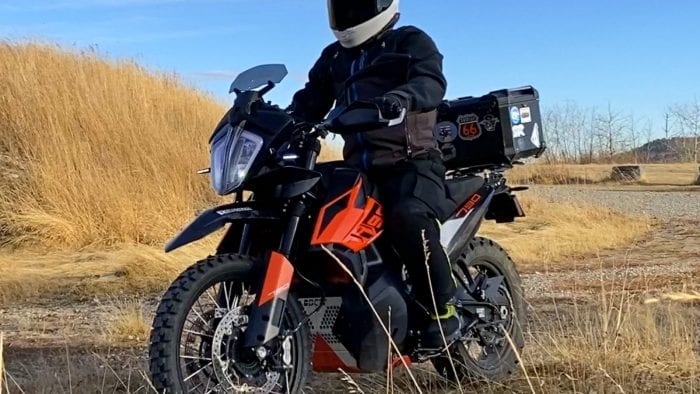

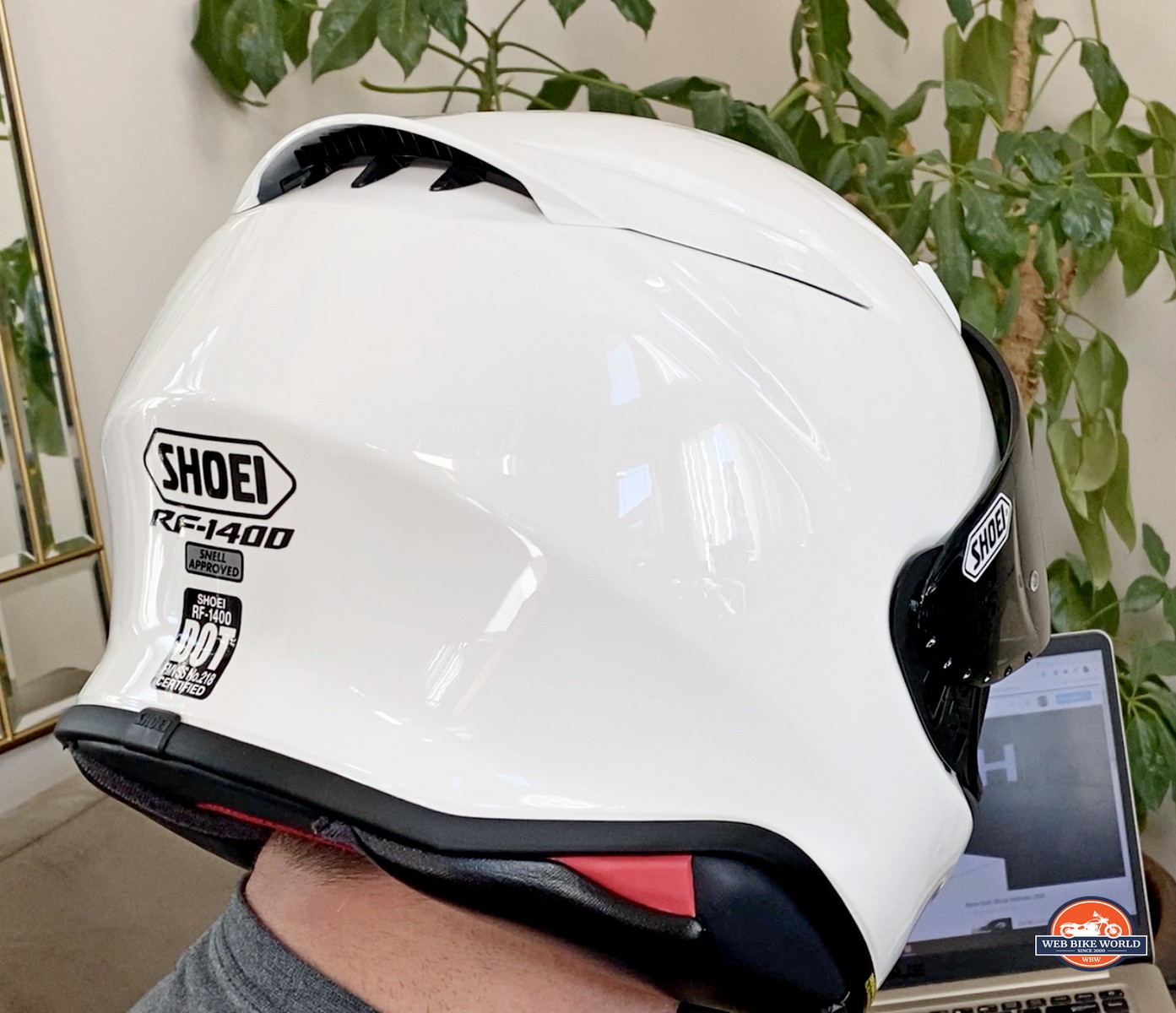
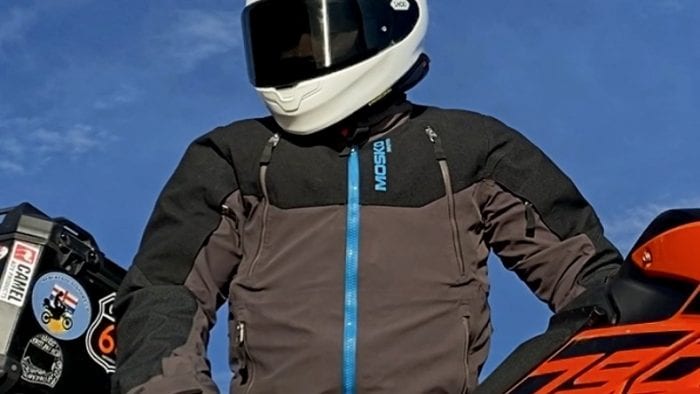
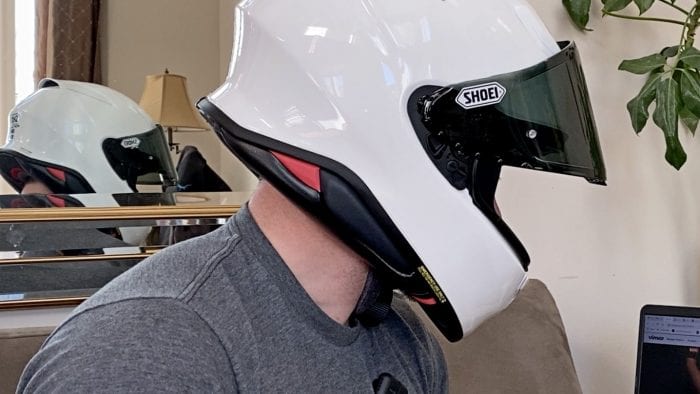
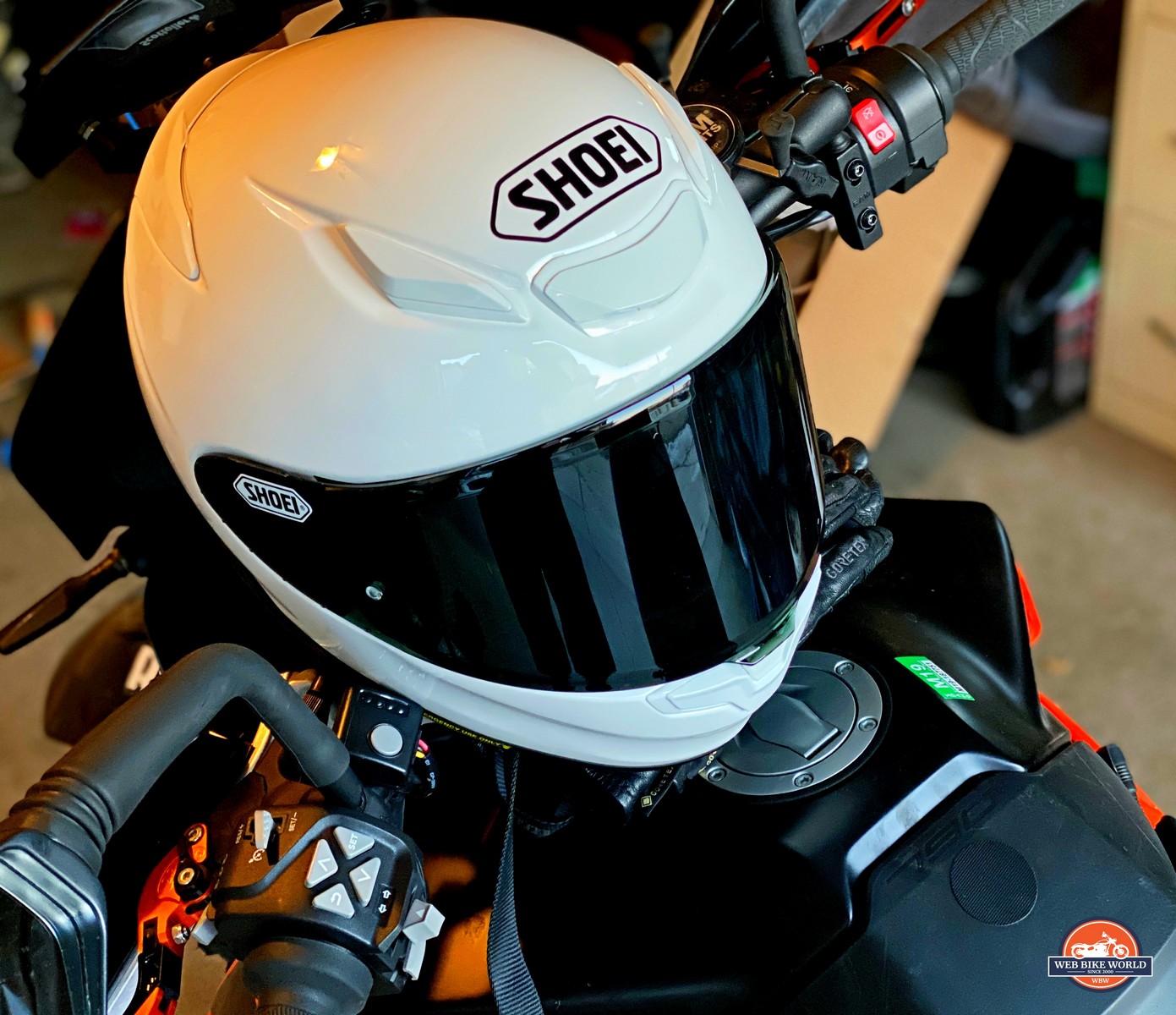

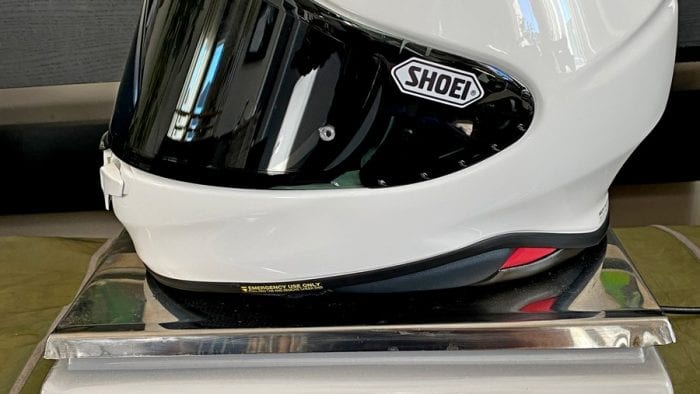
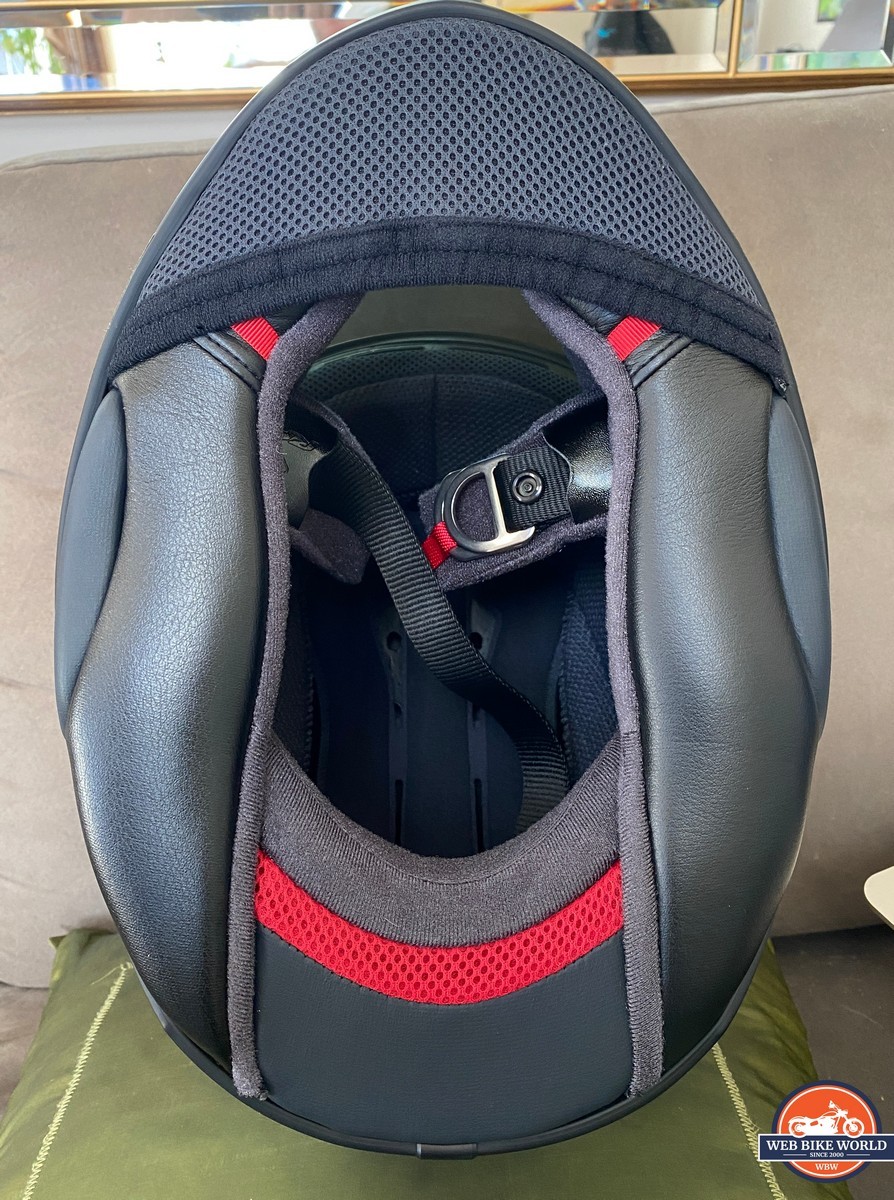
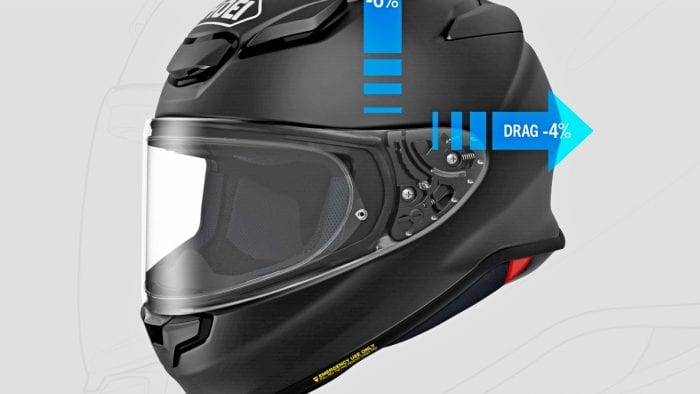
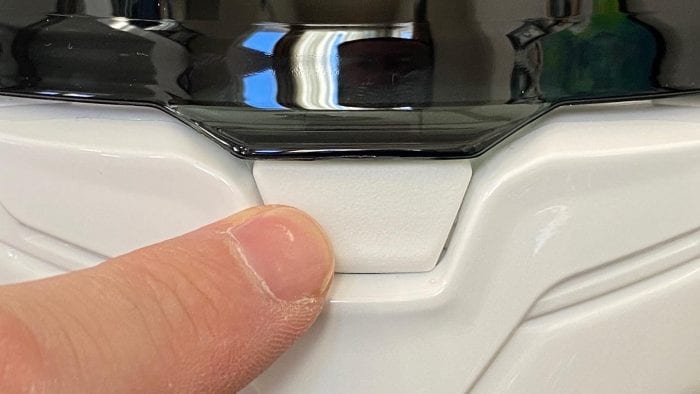
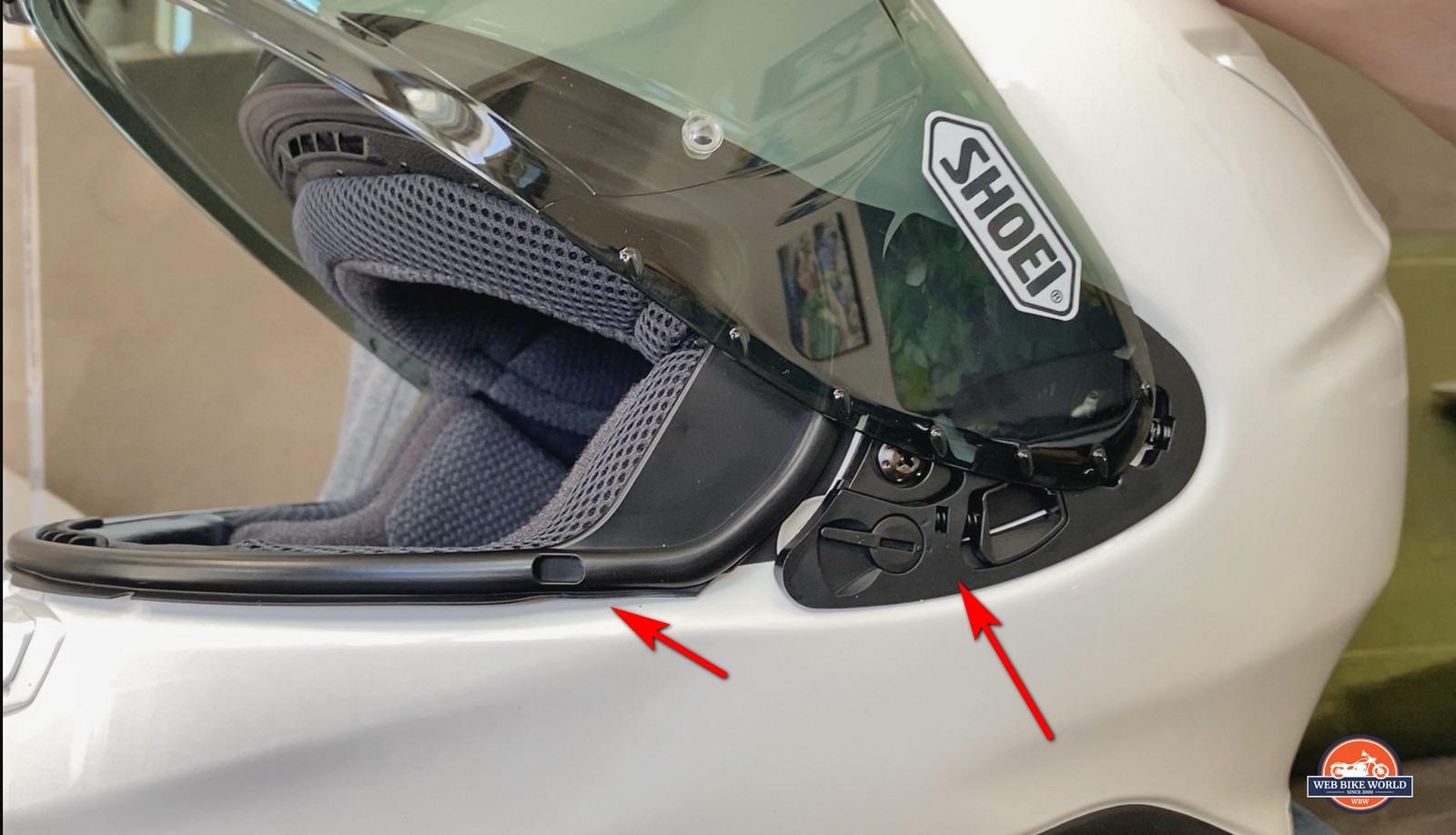

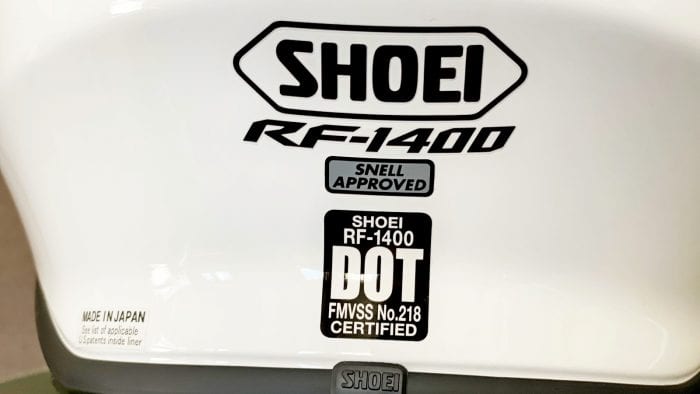
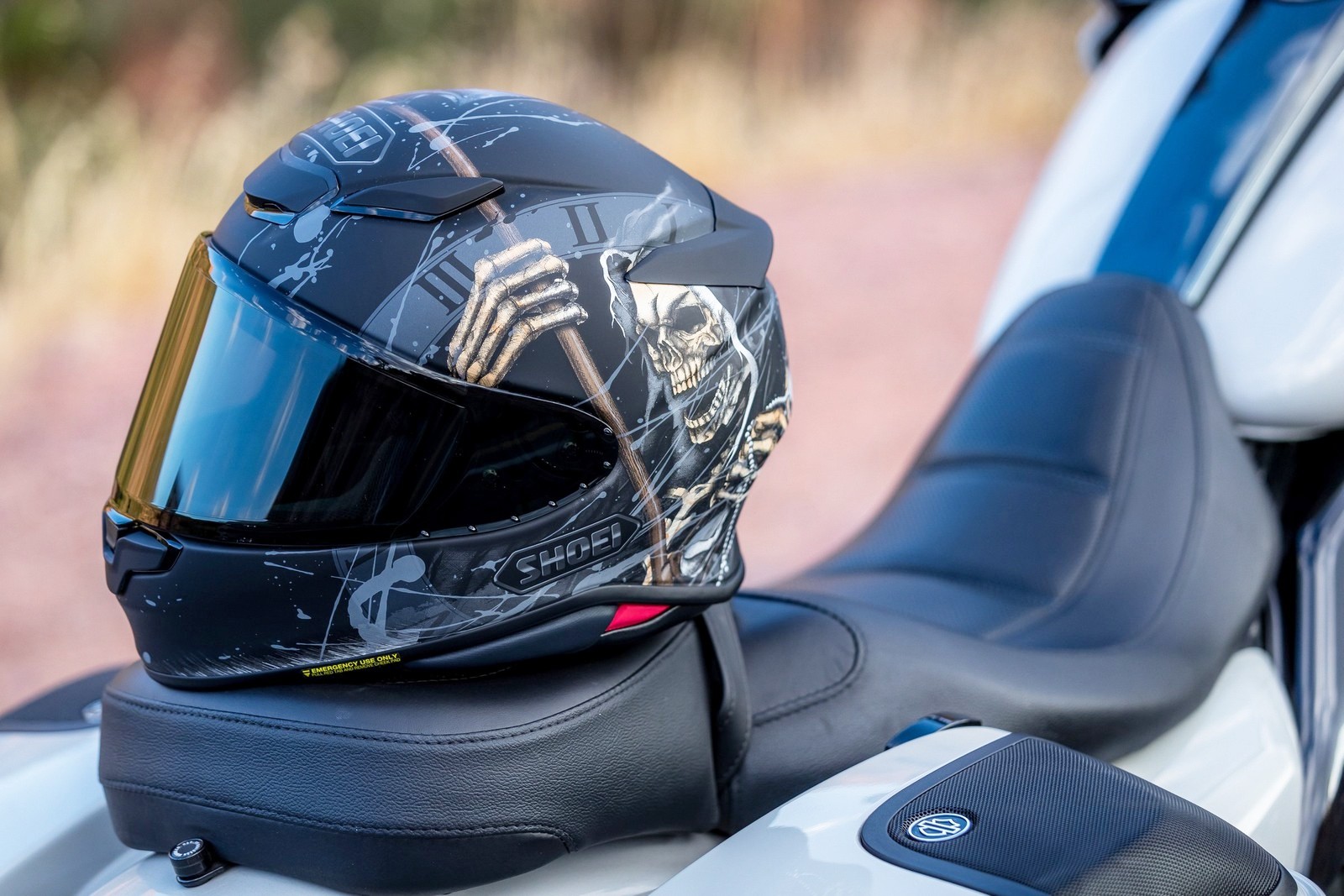
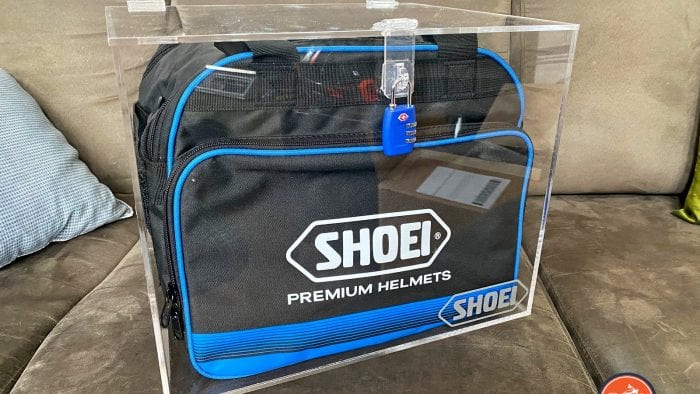
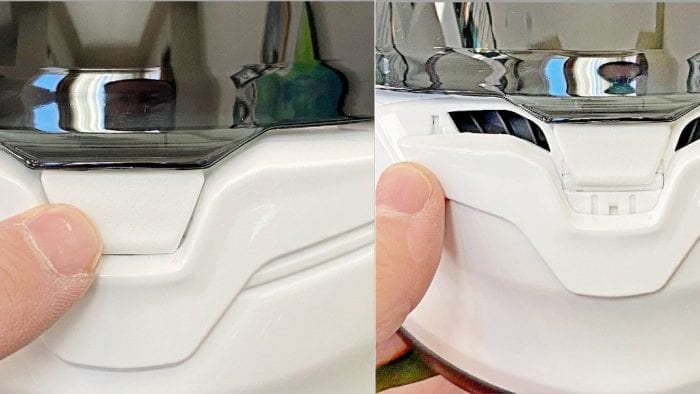
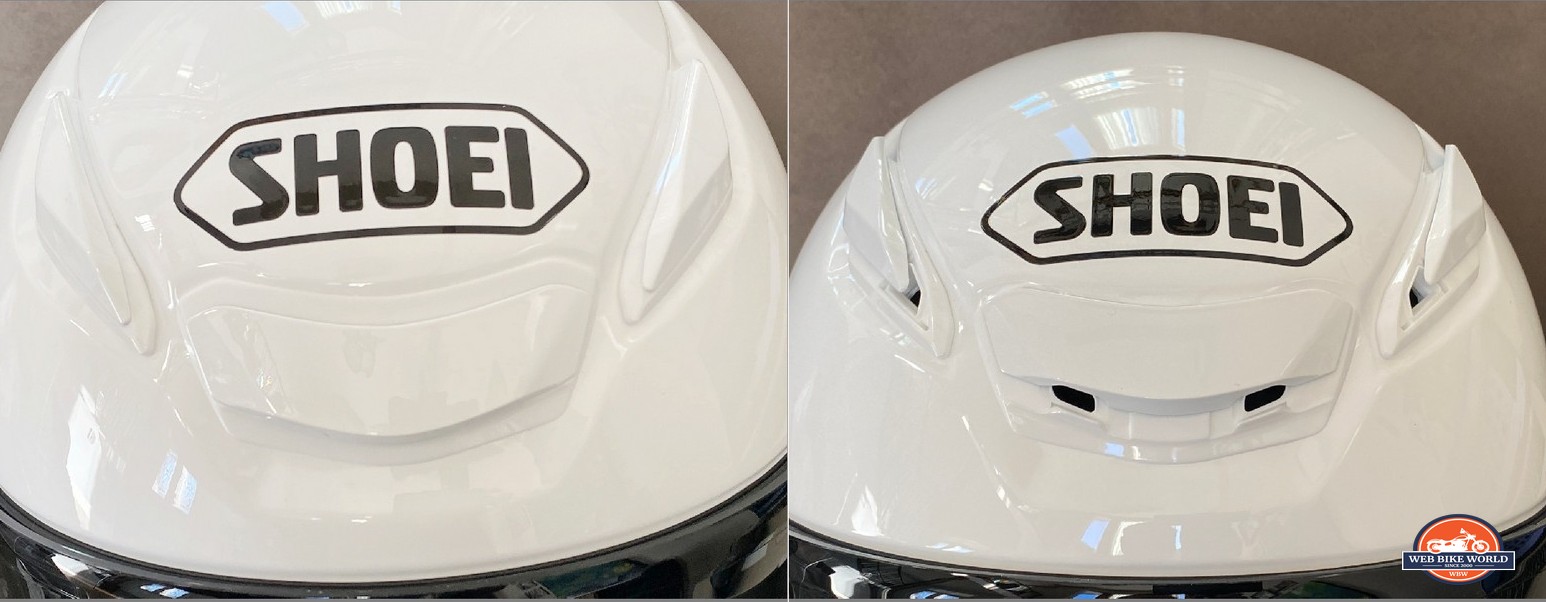
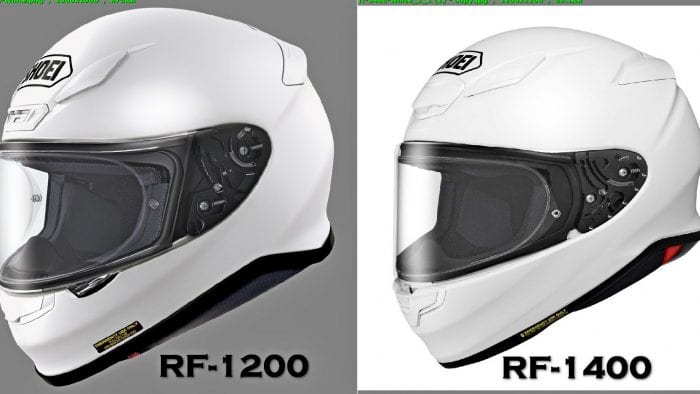

So is it noticeably more round than the RF-1200?
Mike, I really can’t say unfortunately as I haven’t yet worn the RF-1200. I suspect it would be the same shape or very close to it.
Mike, I got an email from our Shoei rep confirming the shape in the 1400 vs 1200 is the same in the crown or upper portion. That means the head shape is the same there but Matthias says the cheek pad area is different on the 1400 thanks to that new wedge design on the neckroll/chin bar. With some fine-tuning on the cheek pad thickness, it sounds like you could get on well with the 1400 if you’re a fan of the 1200.
I have a long oval head shape.
My ready-to-retire, long oval Arai Signet-Q fit correctly from day one, however its successor, the Arai Signet-X, moves more toward the intermediate oval head shape.
A fitting procedure:
With the helmet properly (evenly) positioned on my head and fastened, I press the back of the helmet forward then attempt to insert the index finger on my other hand into the space between the inside front of the helmet and my forehead (starting at the center then moving to both sides of the forehead).
Additionally, when attempting to turn the helmet around my head (right to left/left to right) I make note of where the helmet touches on the sides of the skull above the ears in the widest area of my skull.
It is important to distinguish between skull shape and cheek pad fitment.
The above procedure provides repeatable and predictable outcomes, no matter the head shape specified by the manufacturer, or the efforts invested by the salesperson to sell you a helmet.
I suppose it is possible, too, that head shape differences may exist between XXXXS to XXXXL across helmet brands.
That said, I can only account for size small.
When I tried on several helmets at a local dealer and applied the above metric, not only where there measurable differences–and as much my mind wanted to have a long oval fit like a long oval (because that is what the manufacturer said it was)–the correspondence between the objective measurement and subjective experience of proper fit could not be denied.
The results follow:
• the Signet-Q fit well all the way around my skull.
• the Signet-X created a hot spot on my forehead and had too much space on the sides of my skull, above my ears.
• the RF-1400 fit more like the Signet Q, but with tighter cheek pads (which, unlike the skull shape, will soften a bit over time).
In the small size the Shoei RF-1400 is more long oval than the Arai Signet-X.
The Shoei RF-1400 will likely replace my well worn Signet-Q.
Excellent, logical, detailed and methodical review. Much-appreciated. I watched your excellent video review on youtube, and you definitely deserve a lot more views. (Sorry, I wish I could’ve helped you out with a comment there, but unfortunately I generally don’t post on forms of social media where they intensely track your activity and build a profile on you.)
I came here via a search for quiet helmets, because I’m shopping for a quiet helmet that still provides a top level of safety for a sport touring bike. You’ve provided what seems to be about the best-available info on the noise levels in this helmet thus far.
Even though you forthrightly admit you’re forced to provide a subjective assessment in the absence of more scientific methods, assessing the noise level by putting your head up into the undisturbed air above the turbulence created by your particular bike makes a lot of sense, and I appreciate your assessment that the noise level was excellent relative to other helmets you’ve tried, and apparently you’ve tried some of the best. I find your assessment that the noise level of this helmet equals or approximates that of the GT-Air II to be especially valuable, and very believable given the quality of the rest of your review and that you say you have a lot of experience with the GT-Air II. It also seems pretty impressive if Shoei has in fact pulled this off.
There’s a youtube video by ChampionHelmets (called best Sport Touring Helmets of 2021) where they actually did have the equipment to scientifically measure noise levels (with a microphone inserted next the the ear) of top helmets, and the GT-Air II was found to be the quietest of the group (tied with one other), at 97dB.
However, they don’t seem to have subjected the RF1400 to the same test as yet (perhaps because it the European version hasn’t been rolled out yet?). Therefore, your assessment that it appears to be as quiet as the GT-Air II is the best we have to date, and I appreciate your providing it.
I also appreciate your posting Shoei’s own statements that the helmet has been designed to reduce noise levels – through the better seals at the base of the helmet and chin curtain, helmet shape and the wind tunnel testing, and the little vortex generators (copied from Schuberth, I believe). A manufacturer that makes clear it’s working to reduce noise levels, and provides proof to back it up, is what I’m looking for.
Personally, although noise levels are a top priority for me, they’re not the only priority, and I’m looking for an alternative to the GT-Air II because I don’t care for the ratcheting chin strap and inside visor, both of which prevent the helmet from attaining the higher safety ratings, not to mention the higher price that comes with them.
I’m now leaning strongly towards the RF 1400 because of your review, so thanks a lot for the effort and information. Hearing damage is real, and I already have it from past noise exposure, so I don’t want any more. If this helmet does in fact provide a combination of top level quietness, together with top safety features and ratings, plus a design that works for sport/sport touring and maybe even other types of riding, that’s what I’m looking for.
PS, I’m imagining you might be getting some additional riding in with the helmet by now, so will be looking forward to any updates in the event you post something.
Best regards.
PPS: I’m looking for a high visibility helmet too, and the yellow (or white) looks pretty high visibility to me. So when you say you say they aren’t yet offering a high visibility model, are you talking about reflective coating or reflective strips or something??
PPPS: Thanks for the field of view comments as well. I’m coming from an older Arai and looking at Shoei because of the greater field of view. It sucks to try to take a quick look over your shoulder at highway speeds and have your line of sight blocked too much by the helmet. I tried Shoei on in a store and immediately noticed the greater field of view. I’m sure a smaller aperture for the face is safer in a crash, but that has to be balanced against an adequate field of view that enables you to see what you need to see to avoid a crash.
Hi Skip!
I’m very happy to hear the review has proven valuable to you! That’s what I hope for in creating these ridiculously detailed reports. I almost never find enough valuable info in other reviews for myself. Not to toot the wBW horn too much, but I find much of what passes for “reviews” from other popular sites these days largely inadequate. Having said that, Championhelmets.com is awesome! Thank you for telling me about them. I just watched their modular helmet showdown and appreciate their methods and insight. I think I’ve found my tribe of like-minded people, although I didn’t necessarily agree with their love for the Shoei Neotec 2. Perhaps these helmets are different in Europe vs here in North America? I know DOT vs ECE homologations can definitely affect things like weight, but maybe it can also affect ventilation? I found the Neotec 2 very poorly ventilated compared to the AGV Sportmodular Carbon in particular, and while I haven’t worn the C4 Pro on the road, I found the C4 was also very poor when it came to ventilation even though I appreciated other things about it.
I think I just saw something from Shoei calling the RF1400 the Z8 in Asia (possibly Europe too?), but haven’t confirmed it with my Shoei contact yet. It’s available for preorder on a couple of websites I found with a quick search. I would definitely find out from your local dealer when the RF1400 equivalent will be in your neck of the woods and put it on your shortlist of candidates. I hope that it’s not changed drastically in Europe compared to the Snell M2020D version we have here. I believe in any case the ECE version of Snell (M2020E) could actually be superior to the DOT equivalent if my hunch is right about it because I think ECE is a better standard than DOT. I’m excited about the new ECE 22-06 standard making helmets safer yet going forward.
When it comes to field of view being a priority it makes the 1400 even more appealing. I love my Arai DTX but it just can’t compete with the 1400. My XD4 is likely the favourite helmet in my collection partly because of the massive field of view it gives. The 1400 is surprisingly close to it in that regard. I completely agree with your assessment that seeing better will help avoid crashes which is a higher value than having a smaller eyeport for protection.
Re Hi-Viz, yes I might need to edit that to better explain I’m after reflective patches or decals on the helmet. My friend has an AGV Sportmodular Carbon with reflective bands on the back of it that are so effective at making him easy to see day or night when lights hit it. I think every helmet should have the equivalent on them, not just bright colours.
I haven’t been able to get out riding with the RF1400 more as I would have hoped because I’ve been bogged down with other helmet projects lately. Sad to say nothing else I’ve worn since the 1400 has impressed me nearly as much and I miss it. That’s the only downside to this kind of work. I get some favourites but don’t get a lot of wear time with them once the summer riding season begins when I’m trying out new lids almost every month. In reality all I’m curious about is whether the visor will leak in heavy rain at this point. I don’t expect anything to change with the fit, noise, comfort, or venting. It’s a fantastic helmet. Assuming you find the fit comfortable, I’ll bet you a dollar you end up with it on your head once you try it.
Hey Jim, thanks for the reply. Sounds like you’re very busy with helmet and gear reviews, so I don’t want to take up any more of your time, but I’ll make a couple of comments.
Yes, your article turned me on to the WBW website, and now I’ve started reading other articles and videos you guys have put out. Without a doubt you guys provide more comprehensive and intelligent reviews than many of the other so-called reviewers.
I appreciate reviews that start by discussing what is the design philosophy of the product, meaning simply what overall mission, goal or objective the product seeks to meet, and what choices the designers made to meet that goal, as compared to choices made by designers of other products. If I begin to watch a review and the reviewer omits all that and launches straight into a laundry list of what every button, tab, or lever does, I just tune out.
I’m glad I could give back a little and turn you on to those guys at ChampionHelmets and the real life data they are collecting and putting out. Of course they also give impressions from their rider, so maybe that explains why you had some different impressions than they did.
Well, after all that advanced assessment and calculation about the RF 1400, I went to a local store with high hopes and actually tried one on so the rubber could meet the road. Unfortunately, the sales guy insisted medium was too loose on me, and I think he was probably right, but in a size small I got a pressure point right on my upper forehead. So, apparently I may have a long oval head shape, and Shoei therefore apparently may not be the helmet for me, since I understand everything they make in the US is an intermediate oval.
He suggested I look to the Arai Signet-X because apparently Arai is one of the only manufacturers to make helmets in a long oval shape. I’m sure you know all this already. I read/watched WBW’s reviews on the Arai. But I’m actually disappointed to possibly be forced in the Arai direction because apparently they’re not the quietest helmets, owing to Arai’s design choices regarding the exterior features of the helmet and their unwillingness to make a recession in the helmet for the face shield locks, as does Shoei, giving a clean external surface. I actually currently ride in an old Arai and am hoping to get something a little quieter.
My next step is to investigate whether there’s another manufacturer that makes a long oval shape, but so far I’ve seen multiple sources saying Arai is possibly the only one. So the search continues. Shopping for the right gear can be fun, but it can really eat up your time too!
Okay, good luck and keep up the nice, helpful reviews, Jim.
I wonder where I got the idea you were in Europe? Ah well…
I find Shoei helmets are actually very nice for people with longer-shaped heads in my experience. For example, if you take a look at the GT Air you’ll find it’s close to being a LO unofficially. I have my doubts you’re actually a LO head shape as it’s very rare, but you could be on the longer end of intermediate oval. There’s a spectrum and certain helmets lean one way or another.
LS2 helmets are known to be LO shaped, but I’m not sure they’re especially quiet. Nexx is another good brand to consider for quiet and narrow shapes.
You can tweak the internal shape of a helmet by swapping out the comfort liner as I did with the GT Air 2 in order to get a better fit on my round oval head. I got the thinnest crown liner from Shoei and thinner cheek pads to accomplish this. What you could try is putting a thicker crown liner in the Medium to take up the slack if it was just on the sides you had too much room, or go with the thinnest crown liner in the Small and thicker cheek pads. A bit of a gamble, but if you have a good salesman help they might be able to steer you in the right direction to accomplish this with the RF1400.
The Arai Signet X is one of the favorite LO helmets on the market from what I know. With some Arai helmets you can swap the comfort liner from one helmet to another to change the internal shape. I put a Quantum X liner in a DT-X helmet to get a round oval fit instead of the usual IO liner.
I’m bummed to hear the 1400 wasn’t a homerun for you right out of the gate, but I almost think you’d do well to find a GT Air and see how that one fits if you want a quiet helmet with a longer/narrower shape.
If I think of anything else I’ll let you know.
Jim, I’m glad I checked back in because I just noticed your detailed reply from over a week ago. Thanks for the very helpful additional information, much appreciated. You’ve convinced me I should try on a GT Air. I’ll check the fit, and consider the strategies you mentioned if it needs adjustment.
Even though I wasn’t looking for a modular helmet, low noise levels are such a priority for me that I may decide it’s worth it. I’ll also reconsider whether maybe the liner strategies you mentioned could possibly make a difference for me on the RF 1400.
In the mean time, I had an experience you might find of interest. I tried on a new Signet-X in size Small, and after close to a half hour I simply could not tolerate the hard pressure on the front of my forehead on that helmet either. I just needed to get it off. The sales person said she could see a big red spot there after I took it off, so I felt that confirmed it wasn’t just me being a sissy.
Later, I happened to stop into another shop and saw another brand new Signet-X in Small at a deeply discounted price. I looked at the “born on” date inside and found the reason for the discount: it was born in 03/2017. So it has literally been sitting on the shelf unsold for over 3 years! Nevertheless, I tried it on. What a surprise. Would you believe that this helmet seemed to be the perfect fit? It fit like a glove, although very snug, but was still comfortable and did not bother me in the forehead at all!
Now what is the take away from that? Does that mean the internal helmet cushions shrink over time even if the helmet isn’t been worn? Or does it mean the EPS shrinks over time even if it isn’t being worn? Or both?
I know that EPS has a shelf life because it biodegrades over time, but I thought that just meant it becomes brittle and loses its cushioning properties, not volume. Well, I did an internet search and found an article indicating I was wrong. The article says that in fact EPS “can lose shape and even volume over time.”
Yup, it said “even volume.” I did not expect that, but I think my experience probably tends to confirm it. So not only is EPS becoming more brittle over time, but it may literally be shrinking as well, causing you to lose that snug fit you tried so hard to get, and leading to degradation in safety for that reason as well.
On the one hand, this experiences increases my believe in manufacturers’ claims that helmets really do expire over time. On the other, the helmet EPS has shrunk enough to notice it in the fit after only four years, it makes me loathe to spend so much money on the high end, pricey versions.
Well, the search goes on. Pricey GT Air will get a look.
Edit: meant to say over 4 years old, not 3.
Hi Skip!
I asked Ed Becker the head man at Snell about helmets degrading over time sitting on the shelf in stores and his answer surprised me.
He said they did and experiment with a bunch of helmets donated to them by the California Highway Patrol to measure this idea of foam degrading and they found that helmets which had never been worn Or seldom worn didn’t always show any difference from brand new ones. What did make a huge difference was treatment by the user. Many people set their helmets on their bike mirrors are do other things which poke or flatten out the safety liner. He found some helmets that were 12 years old performed like brand new if they’d been treated with care not to damage the EPS foam.
As for the fitment of the second Arai Signet X you found I suspect it had a different shaped comfort liner in it that was thinner and that’s why it worked for you. Arai comfort liners can be adjusted very easily for thickness.
I wouldn’t have any issue wearing a brand new helmet that has been on the shelf since 2017 (especially an Arai) based on what Ed told me but you may feel differently.
PS, as you could probably guess from the above, I am in the US, not Europe.
I did find this WBW article called “Motorcycle Helmet Reviews (Sorted by Internal Shape)”, which seems to be another example of WBW being spot on in trying to help consumers identify the gear they need, in this case narrow helmets: https://www.webbikeworld.com/motorcycle-helmet-reviews-by-internal-shape/
However, the article is from 4 years old now, helmet models keep changing quickly, and even back then it stated, “NOTE: This table is continuously updated, but “Narrow” helmets have become extremely rare. Most manufacturers have moved to a “Neutral” internal shape.”
Thanks so much for the awesome review! You mentioned ventilation is above average, is there a full face or modular helmet in your opinion that ventilates better? Thanks in advance.
Hi Patrick!
Thank you for reading the review!
Yes, I would say I’ve worn a couple of other helmets that vent slightly better than the RF-1400 but they’re not nearly as quiet. The helmet I think has the best ventilation that I’ve tested is the Klim Krios Pro because it has Koroyd in it for a crash liner. It’s also ridiculously lightweight and good value for the money. I wear it without the sun peak attached and am a big fan.
My Arai XD-4 also has better ventilation and is Snell-approved like the RF1400 is, but it’s a very different style of helmet.
I haven’t worn any modular helmets I would say are better than the 1400 is when it comes to ventilation other than maybe the Touratech Aventuro Traveller Carbon but it has a number of issues I found irritating about it, unfortunately.
The AGV Sportmodular Carbon is quite good for ventilation and is very lightweight, but it’s quite loud and has some quirks about it that turn off quite a few people.
Overall I think it’s difficult at this point to find a more well-rounded, full-face helmet than the RF-1400.
I bought a RF 1400 after many years of RFs. I’m disappointed with the visor.
The real problem is the lower (first few) detents don’t stay open. The visor closes until you upon it up about half way. I think it is 2 things. First, the notches that create the detents are smaller and have rounded corners. Secondly, I think the spring that pulls it back, also pulls it down. So it does NOT stay open to allow some ventilation and the first few openings are useless.
I have emailed Shoei US for help, in case there is a solution and will report back.
I don’t really like the centre tab and the lock, but it’s not deal breaker. You don’t have to push it all the way down to lock (making it harder to open since you need to push and lift at the same time) and the hand is in the way of your view for a bit, which seems silly. Hopefully they will fix this as a modification.
Otherwise, it fits like every other RF before it for me. Better fit than the GT Air II (which seemed a little looser, particularly front back, so the GT Air II may be a little longer oval or just a more relaxed fit). What killed the GT Air II for me was my glasses wouldn’t fit. The slot is just in the wrong place and forces the arms of my glasses above my ears and oddly, crookedly side to side. I was even prepared to put up with the micro-latch (with the rubber piece removed – a tip I read) to get the sunshade and the possibility of Sena integration, but the RF just fit and felt better.
I’m only replying to your comment about the face shield latch now being placed in the center on the RF1400. I don’t own the helmet, but I did wear it for half an hour in the store and operated the shield latch many times. In contrast to yours and other comments I’ve seen posted in forums, I really LIKED the center latch, and thought it was excellent in fact. I think it’s much better than pushing or pulling the face shield asymetrically and crookedly from one side, which I’m tired of doing in other helmets, and I didn’t feel like two separate motions were necessary to make it come up. As I pushed the button in, my finger was already in contact with the surface you have to push up, so I just pushed and swept my finger up in one easy, continuous motion. I actually hope Shoei doesn’t allow all the negative comments it’s getting to cause it to change the design, because I hope it becomes standard for most helmets.
I like the center button as well, Skip.
Hi David!
I think there’s an issue with your visor because mine will stay open in the first or barely cracked open position without issue. Hopefully Shoei can shed some light on it for you.
I agree the GT Air helmets are narrower than the RF1400, which is why it fits me without having to install completely different crown and cheek padding.
Thanks for sharing your experience with the group!
Jim, I’m replying your comment about Ed Becker of Snell saying they found little or no deterioration in EPS with unused helmets multiple years old (webpage not offering me a reply button under your comment). VERY interesting information you provided from Becker, thanks for it. It goes against the statement in the article I found that EPS can lose volume over time, but that article didn’t provide a source for the claim. Who knew helmets & helmet tech were so interesting.
Thanks also for the comment that you think the difference in the two new Signet X’s I tried would likely have been due to different, or differently adjusted, comfort liners, and that the thickness can be very easily adjusted. Too bad the salesperson at the first place didn’t tell and show me that. I’ll find out how that can be done. But I’d still like to try for a quieter helmet, if possible.
I tried changing to my lower, stock windscreen on my bike, that allows my head to be more in the free air more, and it reduced the roaring a noticeable amount. Probably goes to show I was unfairly blaming some of the roar on the helmet, when it was the turbulence coming off my windscreen that was partially responsible. I wonder how many riders, like me, started on a quest for a quieter helmet without realizing their problem was largely due to the turbulence from their bike/windscreen(?). Probably a lot, and meanwhile the helmets are being blamed for the noise in forum comment sections. Nevertheless, I do a lot of high speed riding, so helmet noise is still an issue even in clean air.
On another note, I’ve become interested in the Shark Race R Pro helmet because Brian at SportBikeTrackGear says in a video round up of sport/track helmets that it is by far the quietest sport bike helmet he’s ever found, and he’s tried many, and he thinks the reason is because the helmet is designed so aerodynamically sleek. I find the claim very plausible (in comparison, the Arai’s have those little bulges over the face shield hinges). But I can find no place where I can try one on. I’m guessing maybe you haven’t tried one either since they seem kind of rare and perhaps you are not that oriented towards sport/track bikes(??).
Skip, we’re very close to having Makenzie (our resident track rider/reviewer) do a review on that Shark Race R Pro. Having trouble sourcing it from Revzilla at the moment.
I just reviewed the Shark Spartan GT Replikan. The first Shark helmet I’ve ever worn or reviewed. There are many things to like about it (like the quick release visor! Best ever) and it was fairly quiet except when I turned my head left or right, up/down. The Shoei GT Air and GT Air 2 are quieter along with the RF1400 in my opinion and I would buy them first over the Spartan GT. The Spartan GT also has a fogging visor problem which was very disappointing.
Thanks Jim, I just read your excellent Replikan review and dropped a comment below. Your comparisons on noise levels are much appreciated, and at this point your observations that the GT Air 2 and RF1400 are the quietest you’ve tried are my #1 trusted point of reference. I’ll look forward to Makenzie’s review of the Race R Pro if you guys can get your hands on one. If so, I’d especially like to hear what he says about noise. I won’t drop a link here, but he can look up Brian Van’s review from 2017 where he said it was quieter than any other high end track helmet. Based on your suggestions, I’ll be going back to see how my noggin fits in a GT Air 2.
No worries Skip we’re glad to try and help.
If only they would come out with visors for this model! It’s pretty insane to me that for how long this helmet has been out that there aren’t visor options available.
Hi Chris!
What kind of visor are you waiting for? I just looked on Shoei’s website and it looks like there’s a good number of options there for the 1400. https://www.shoei-helmets.com/technology/shoei-shield-tints.html